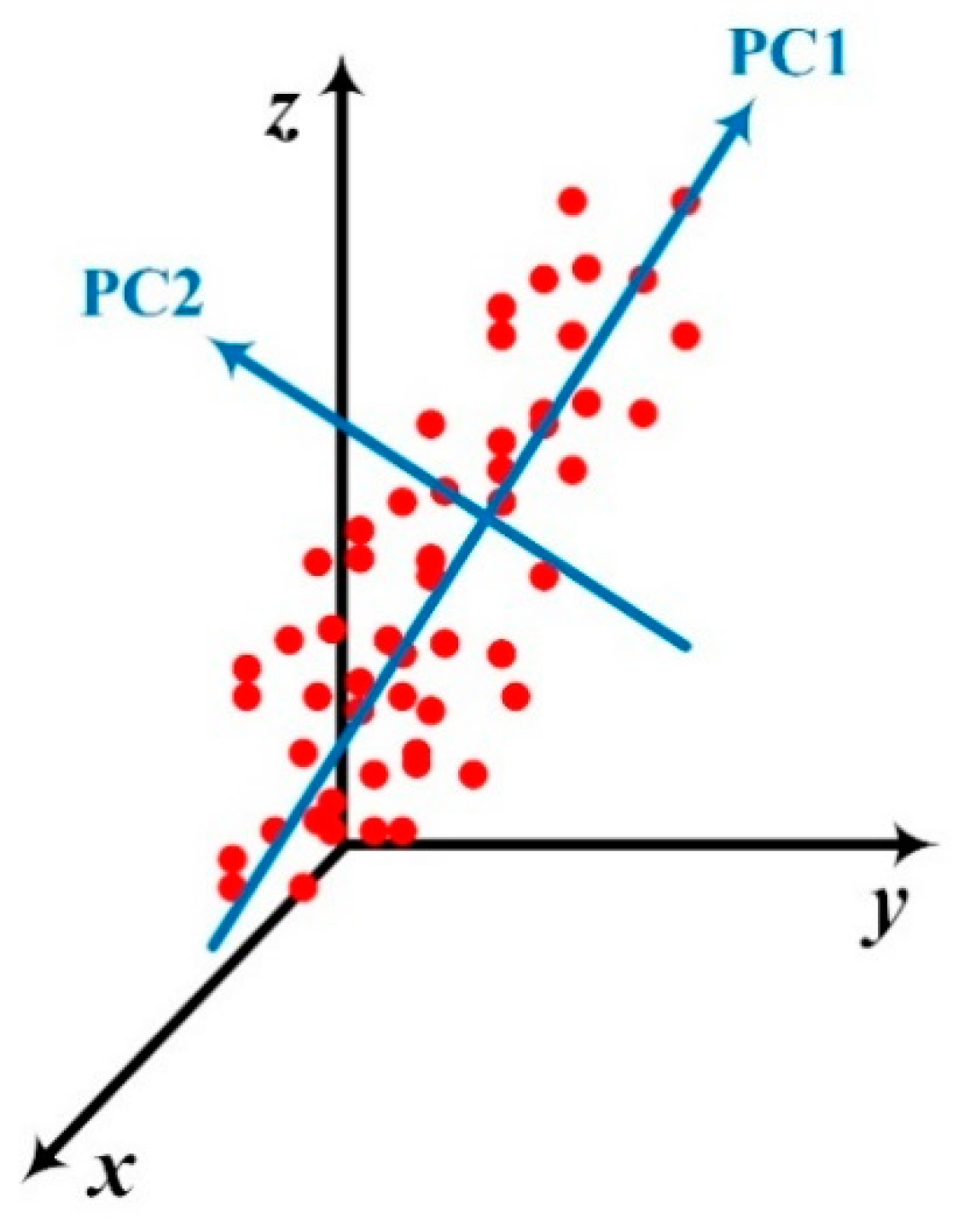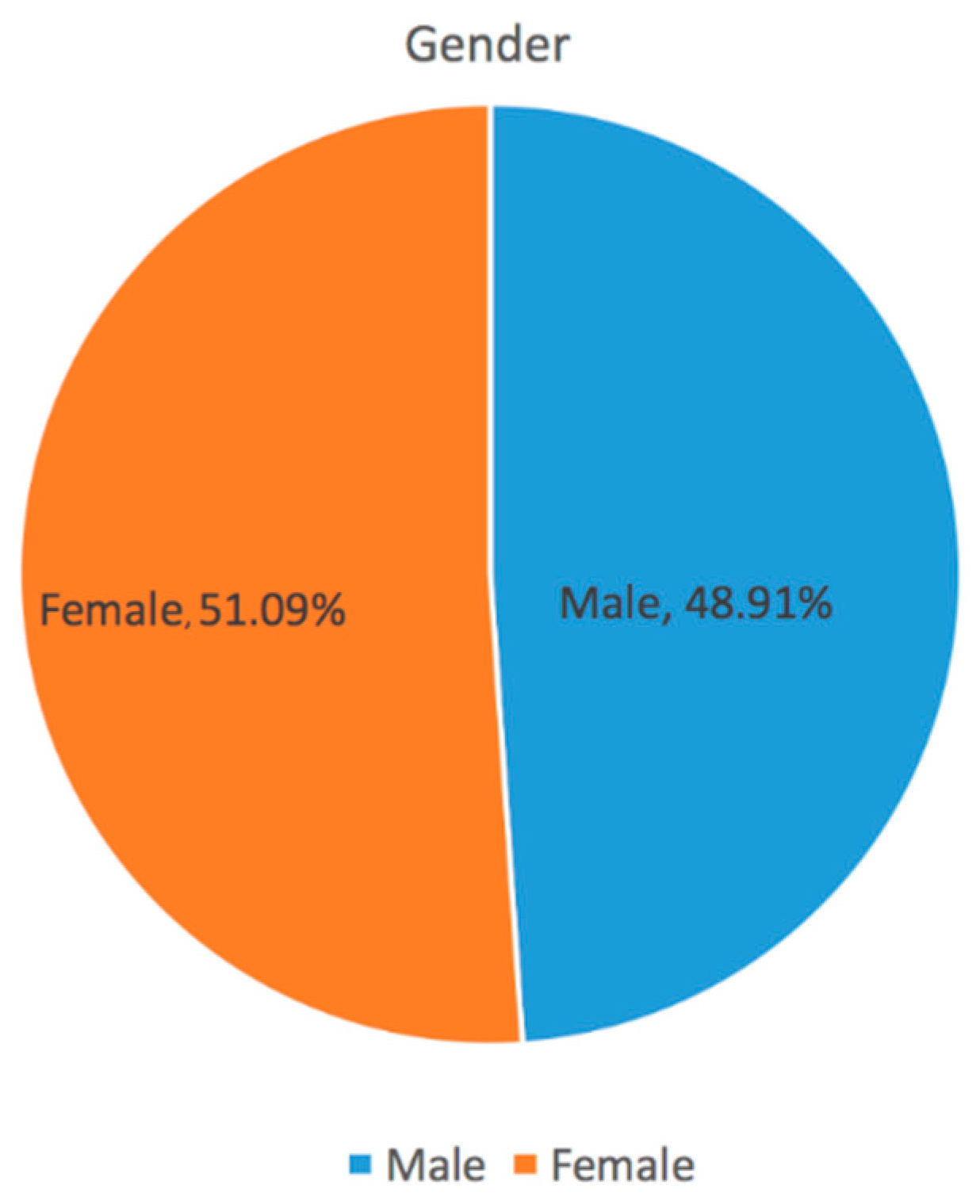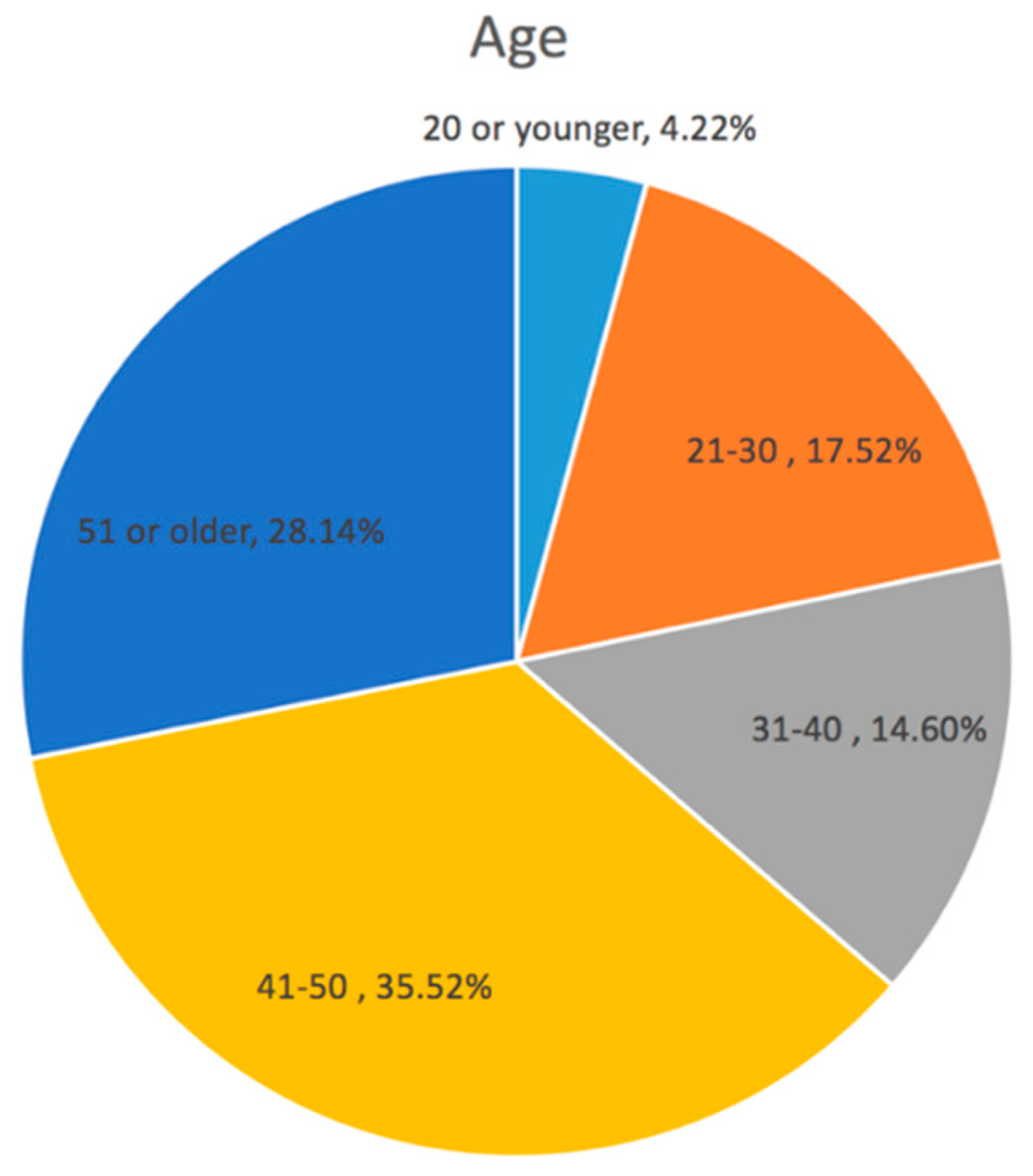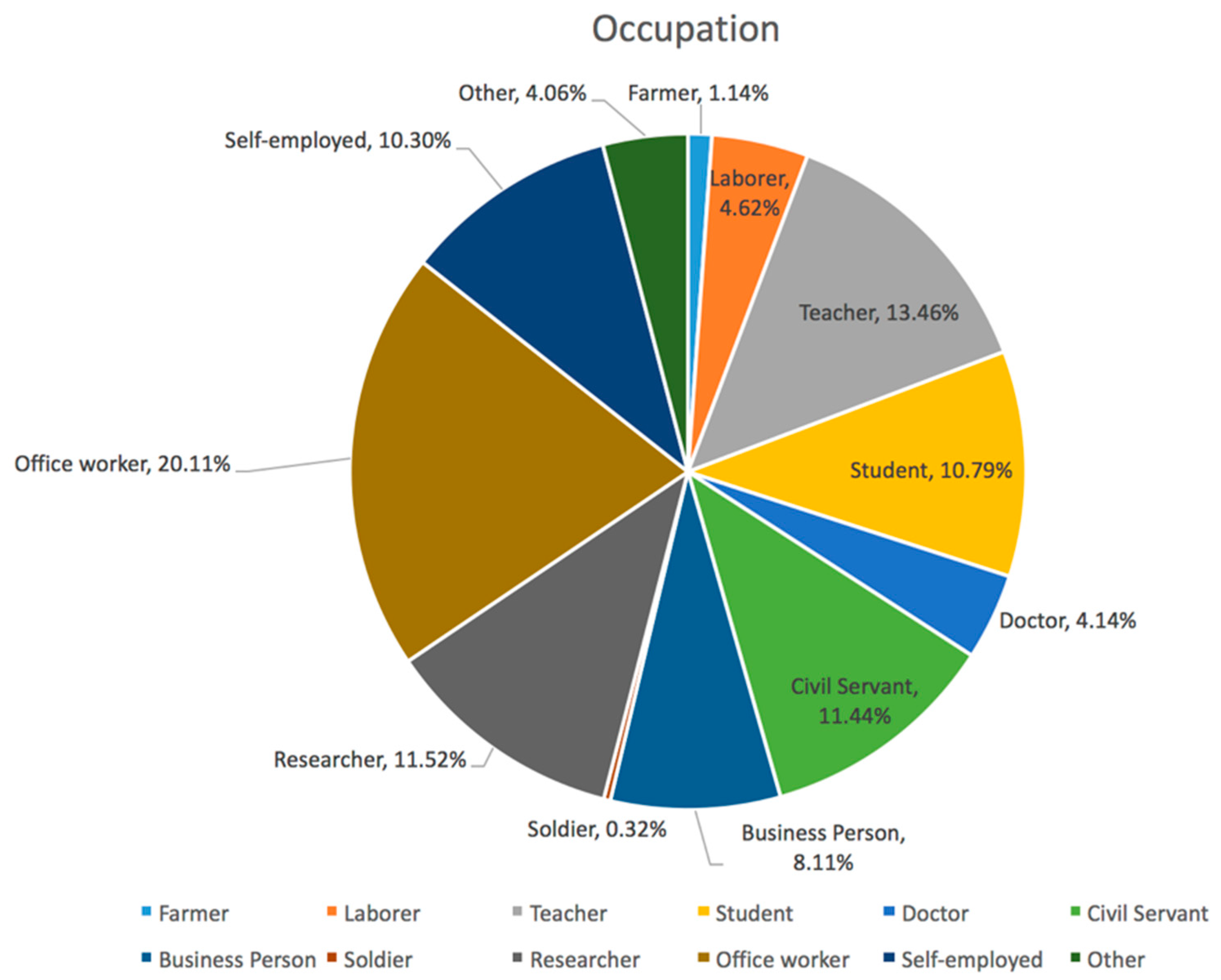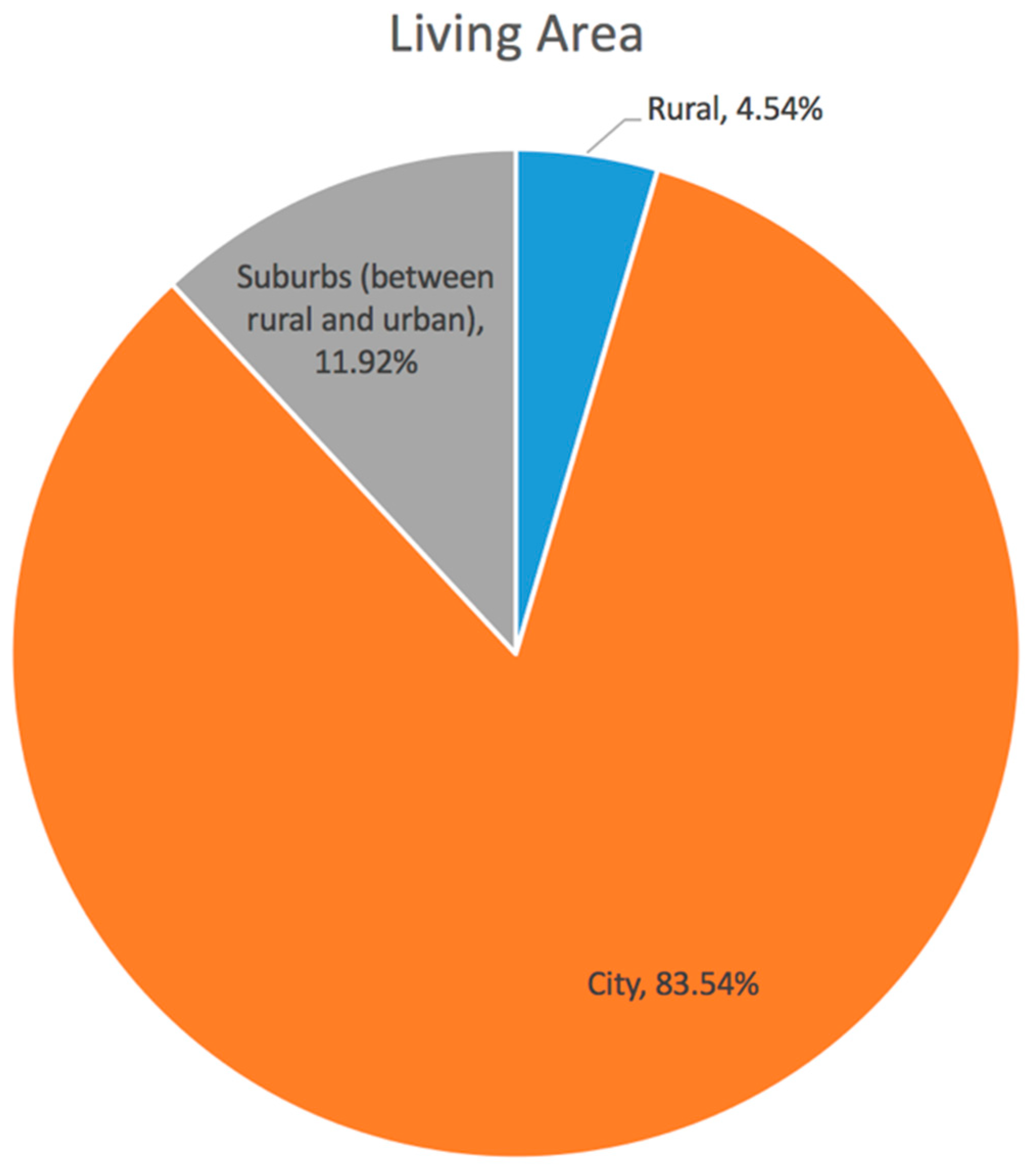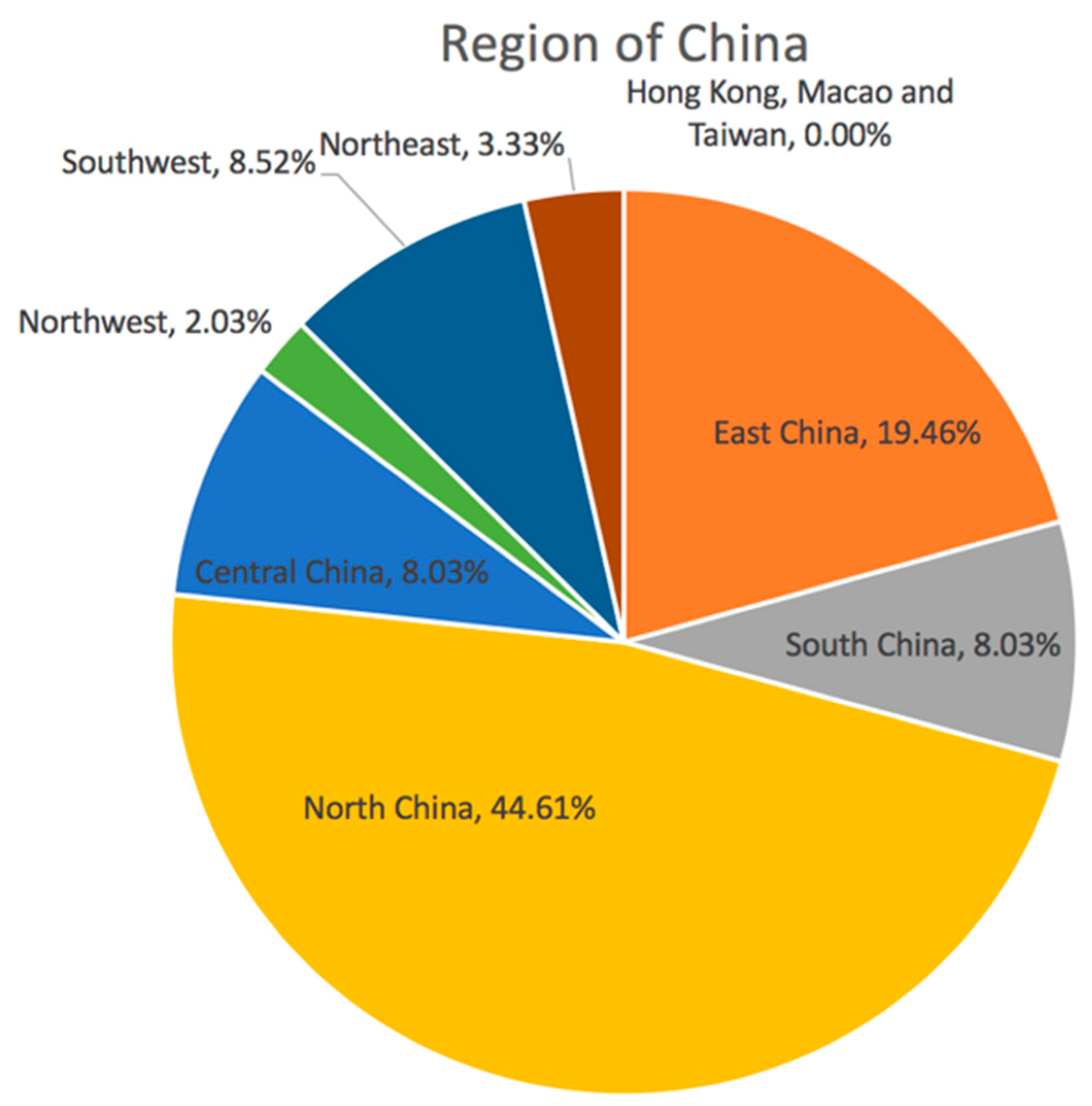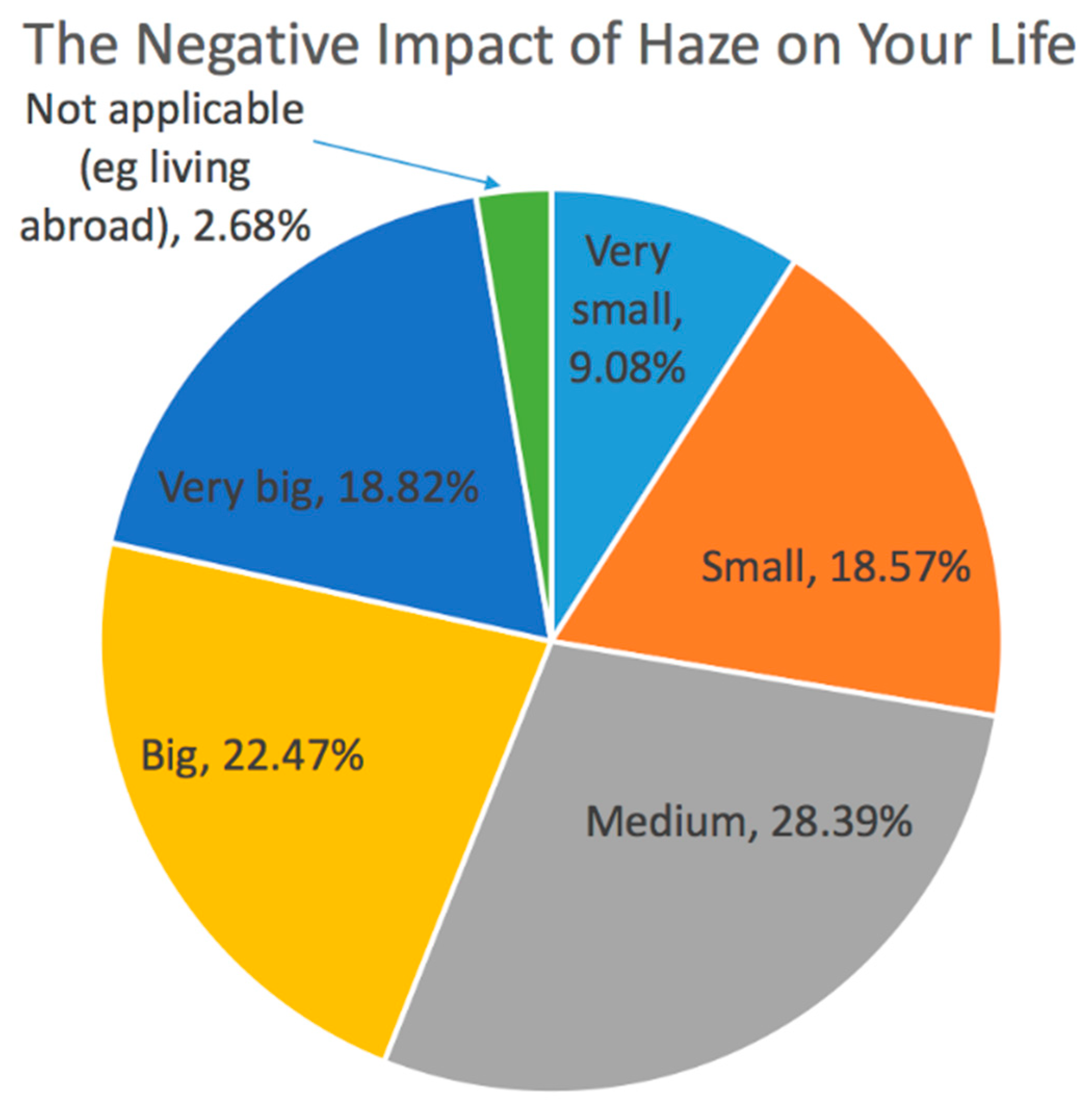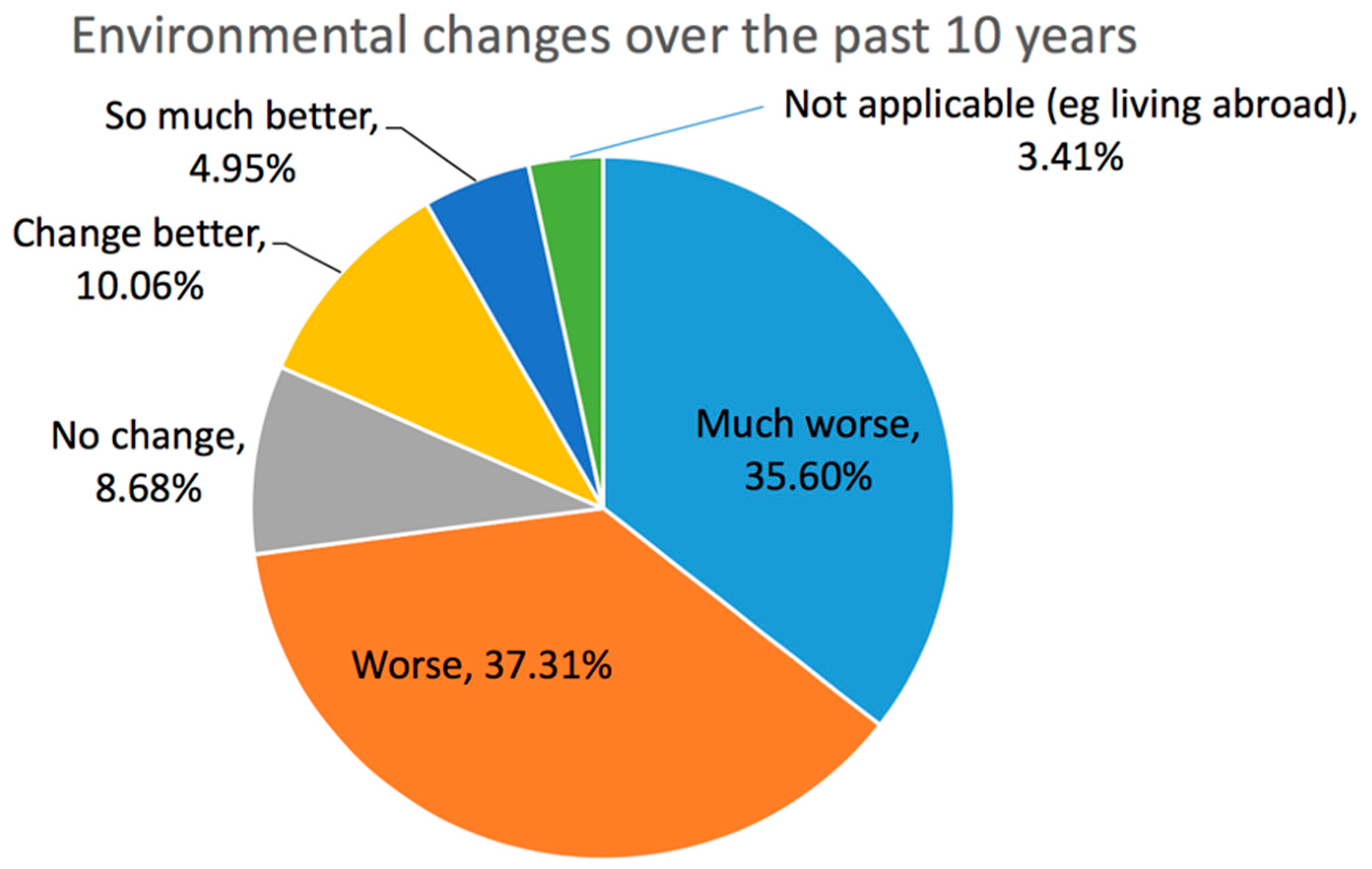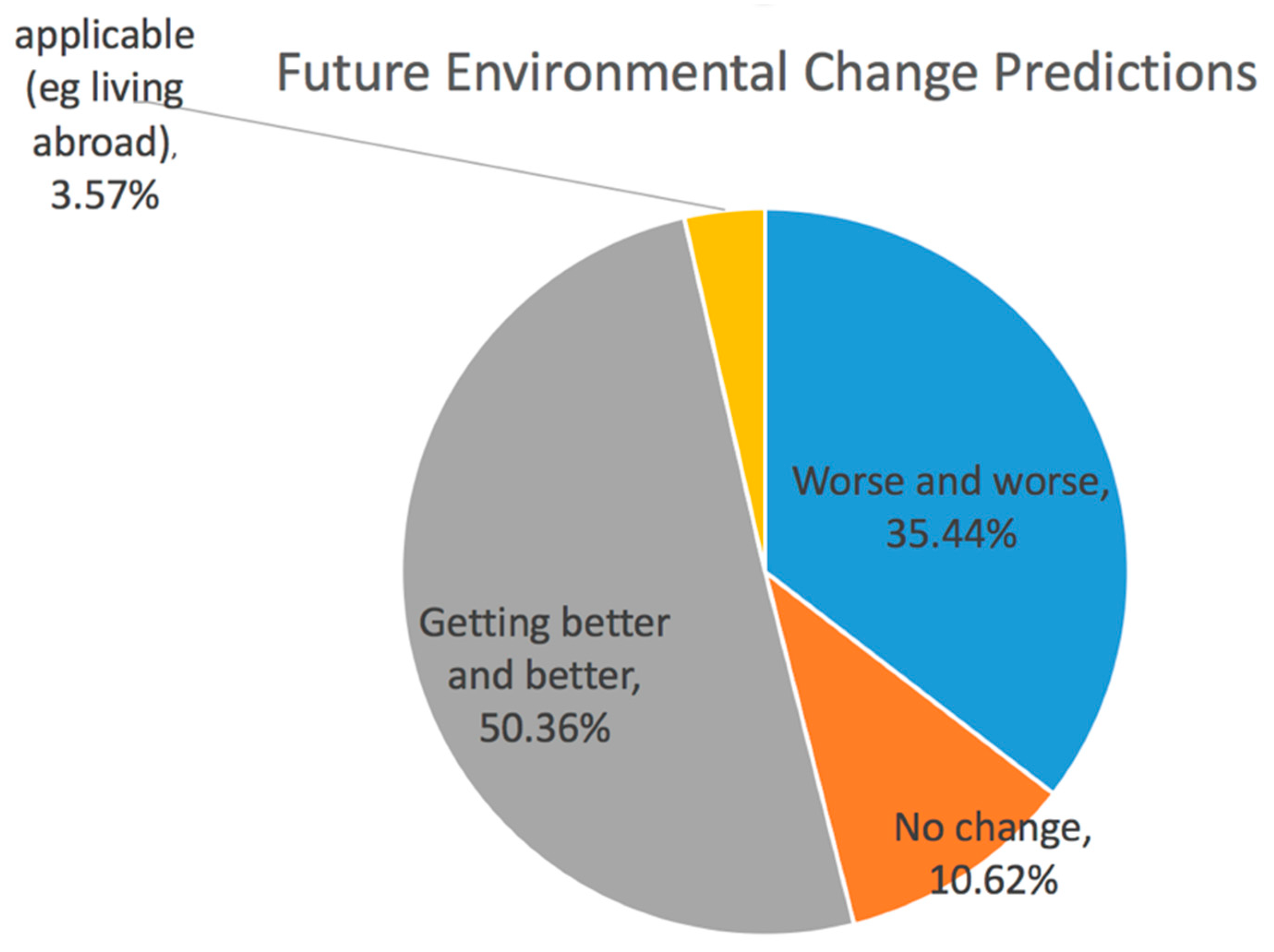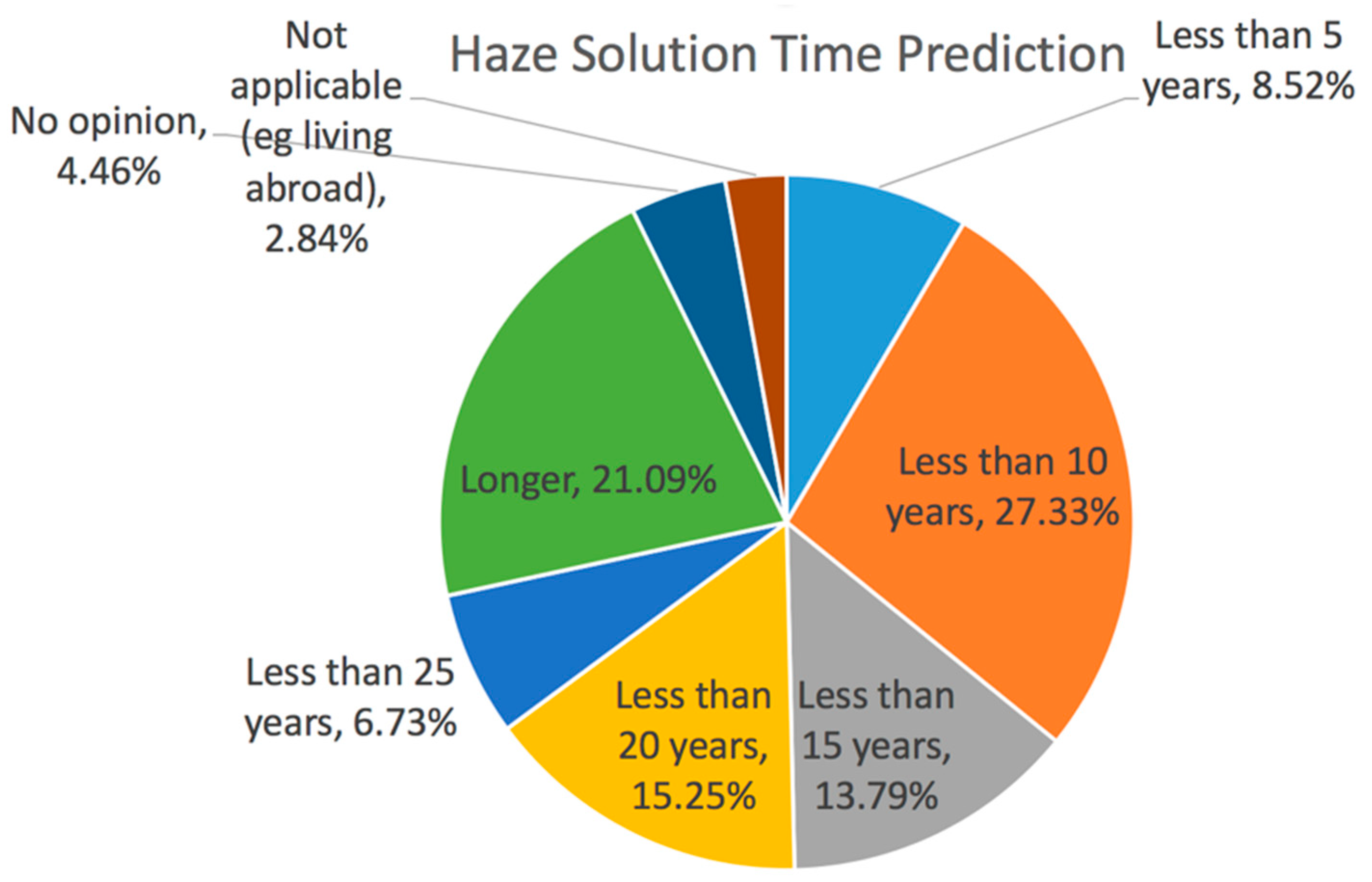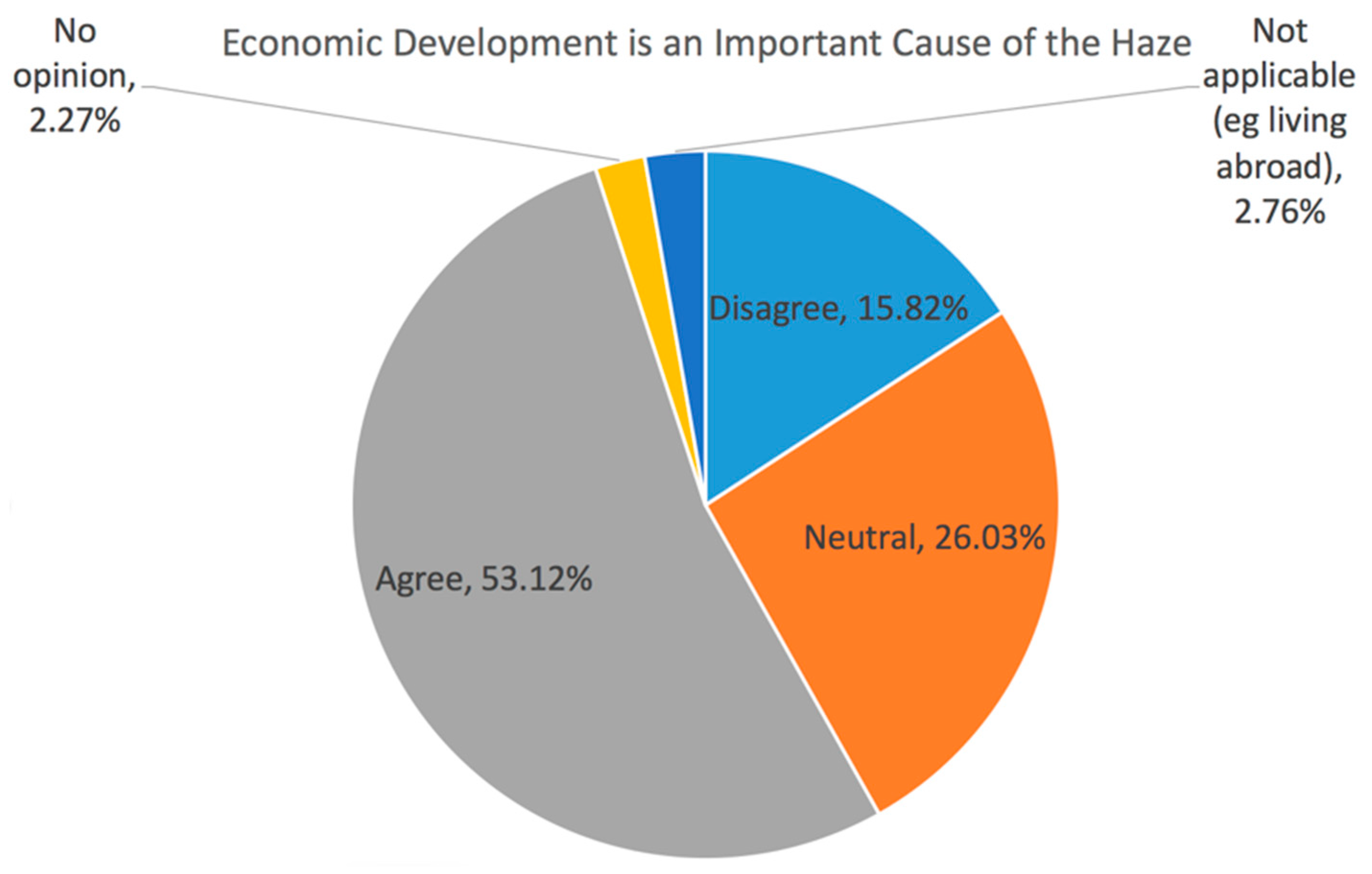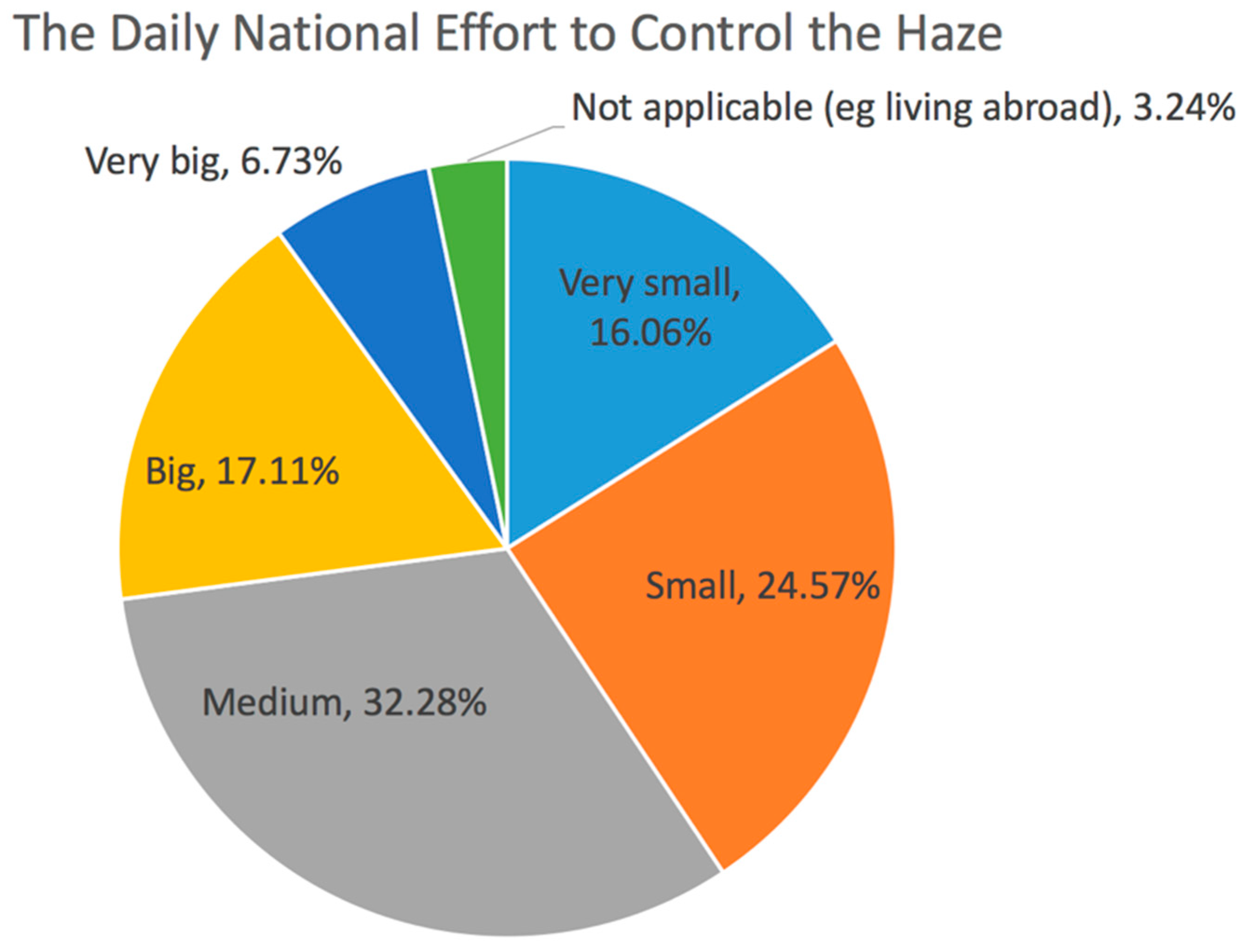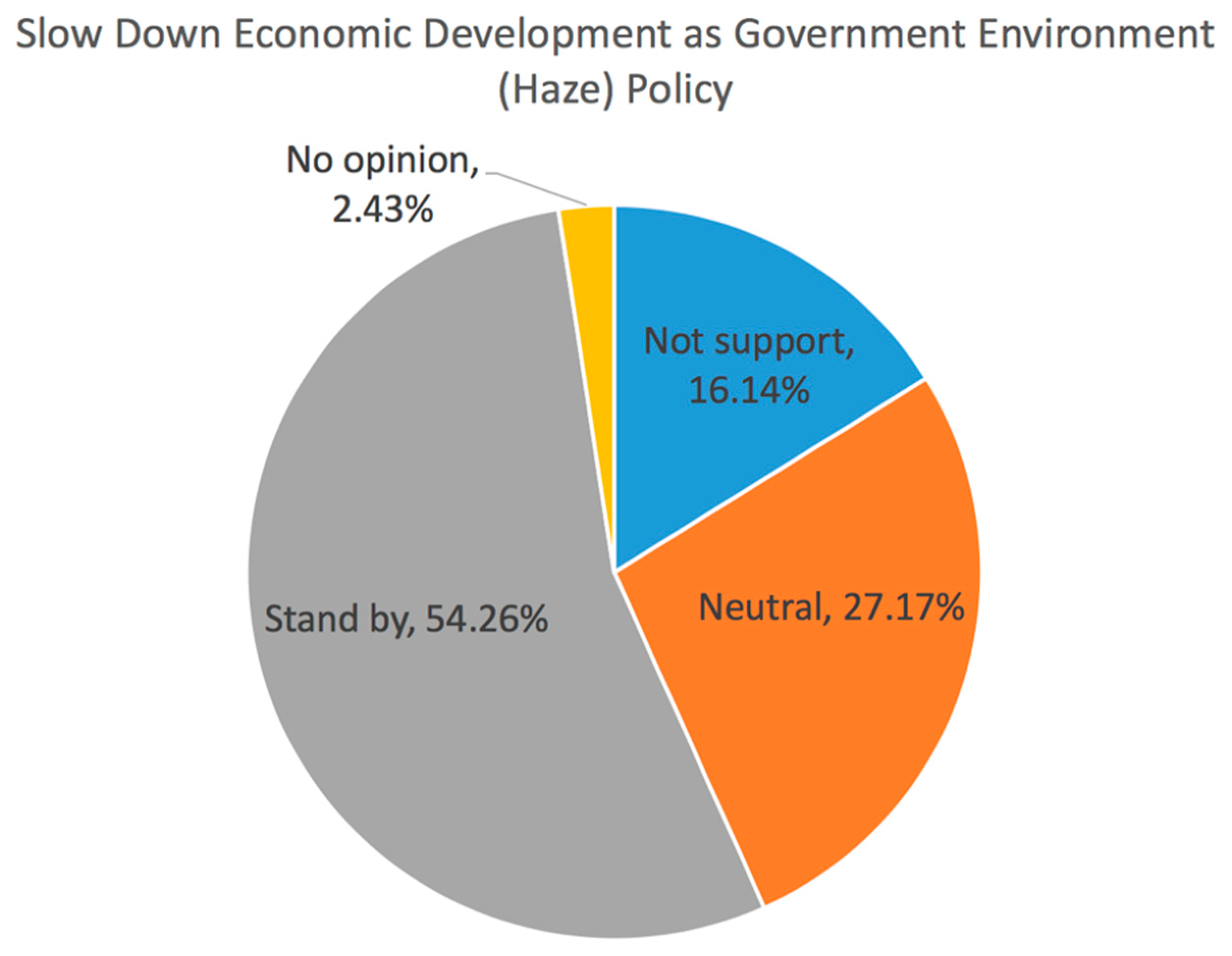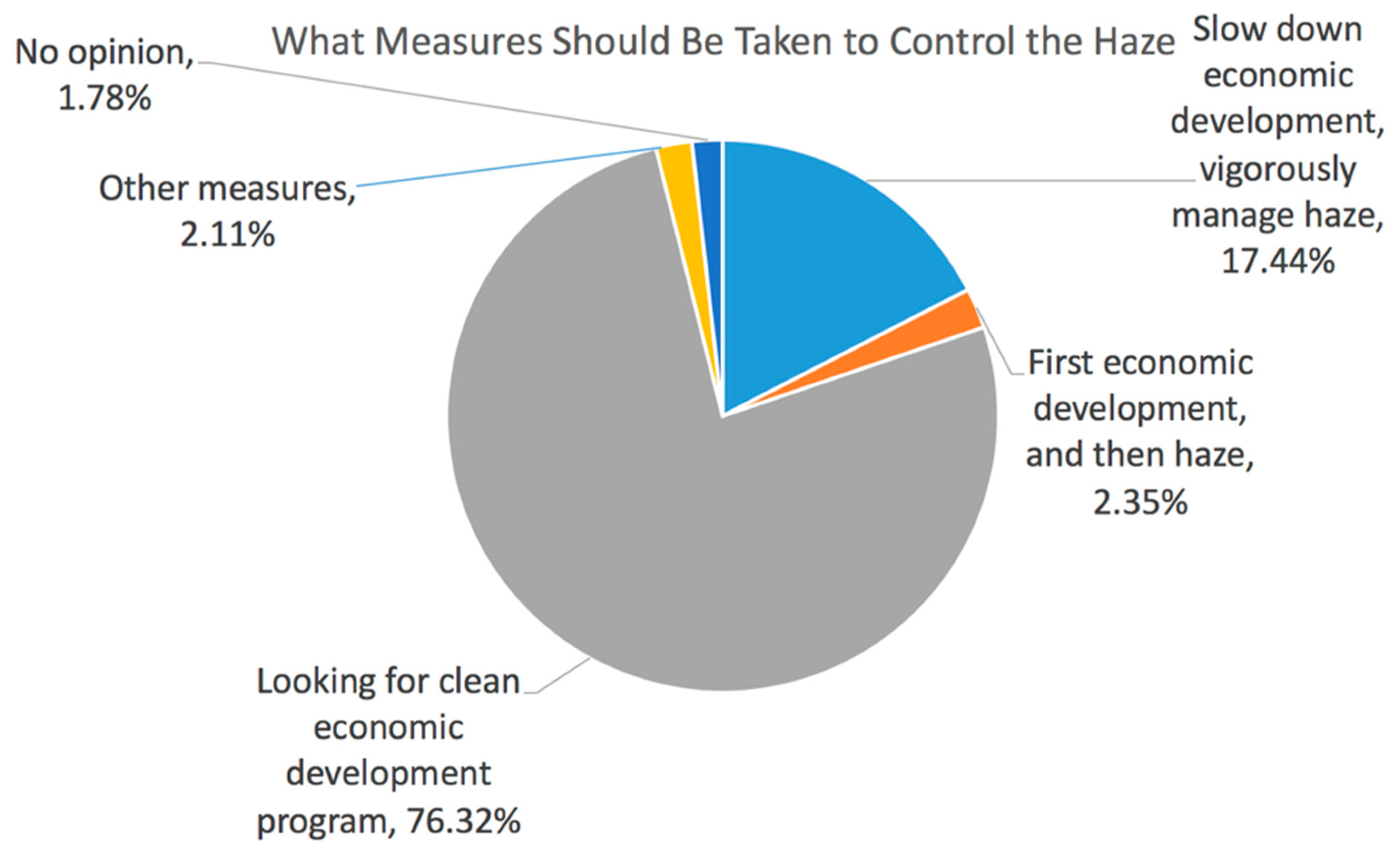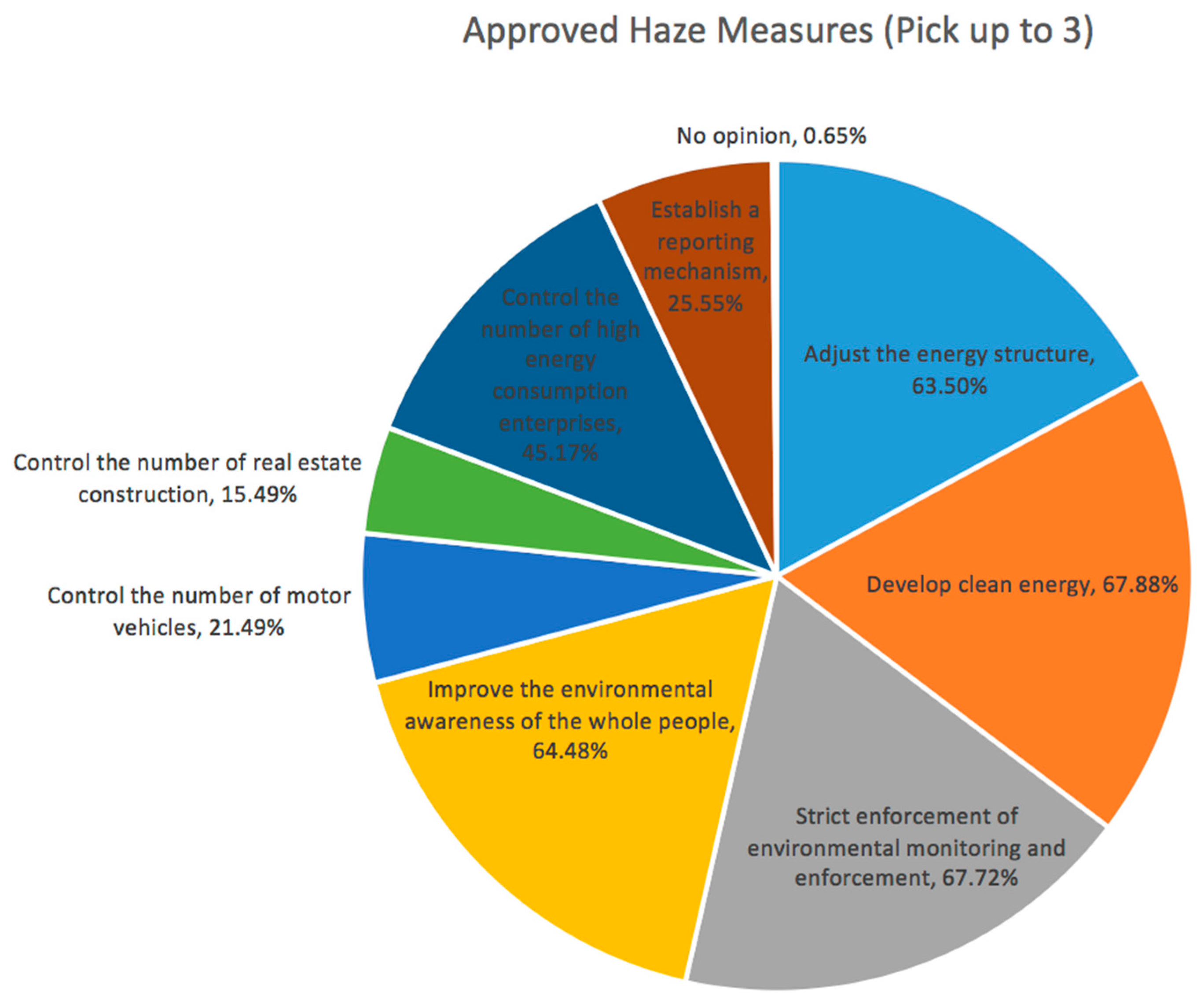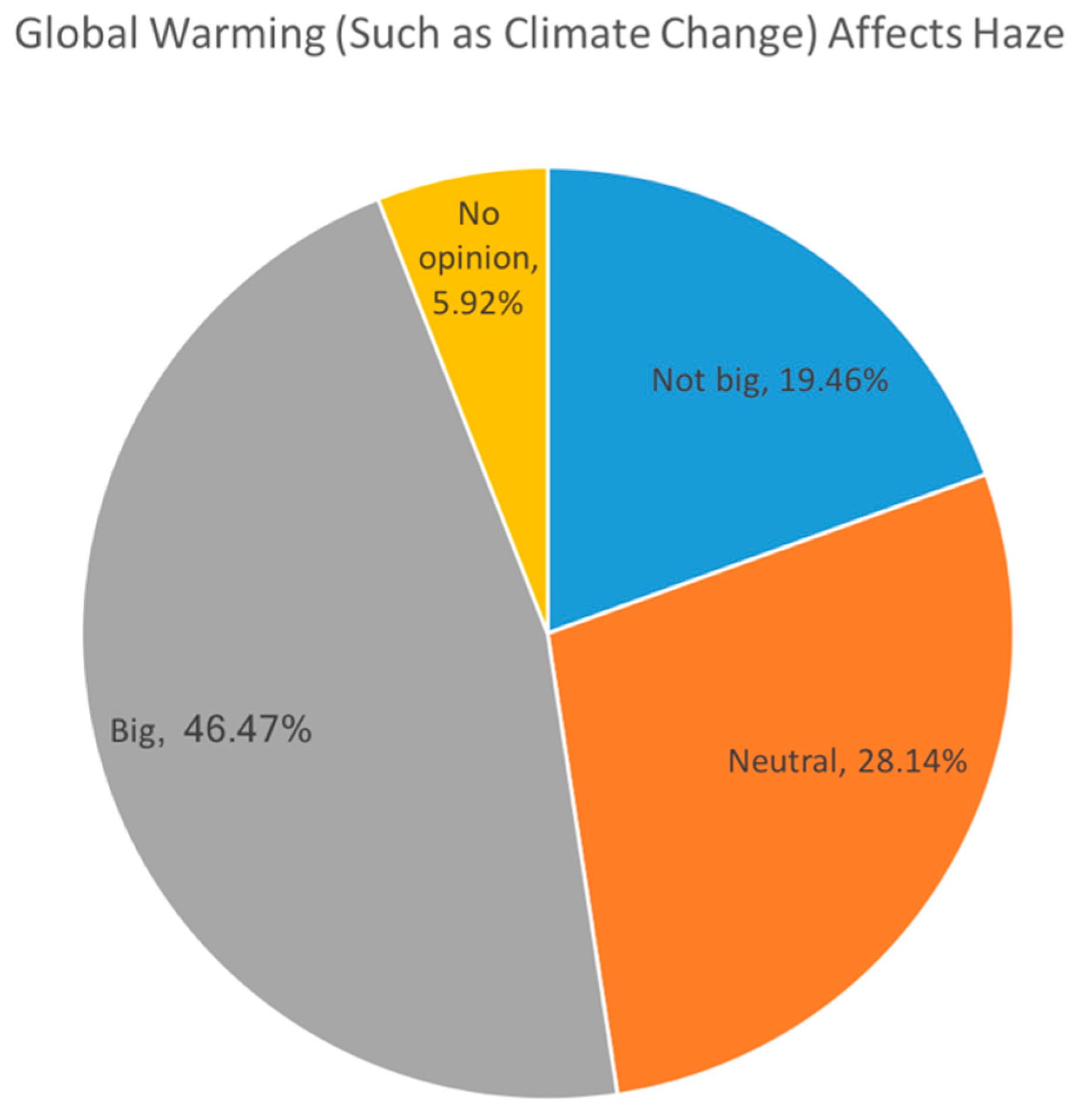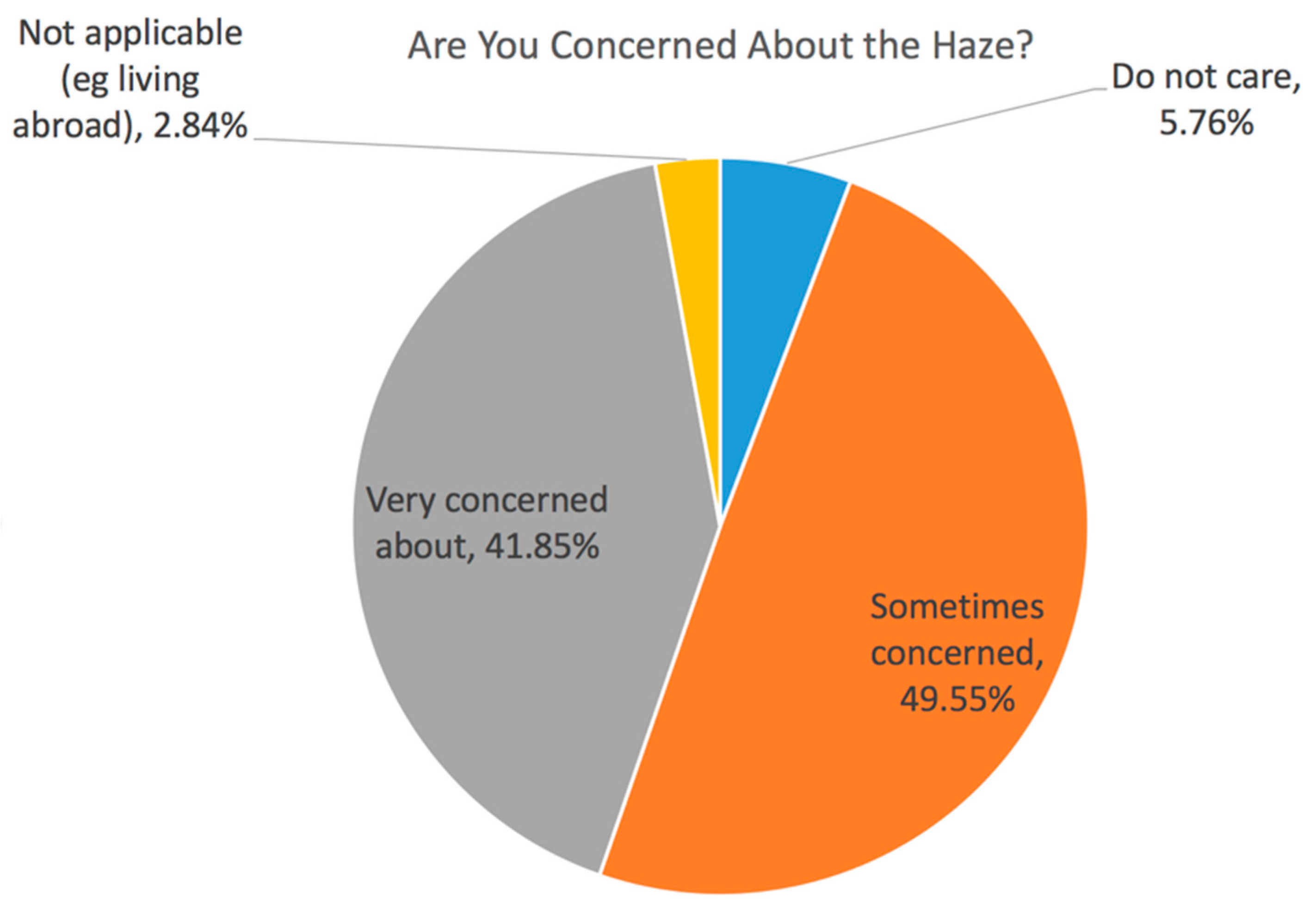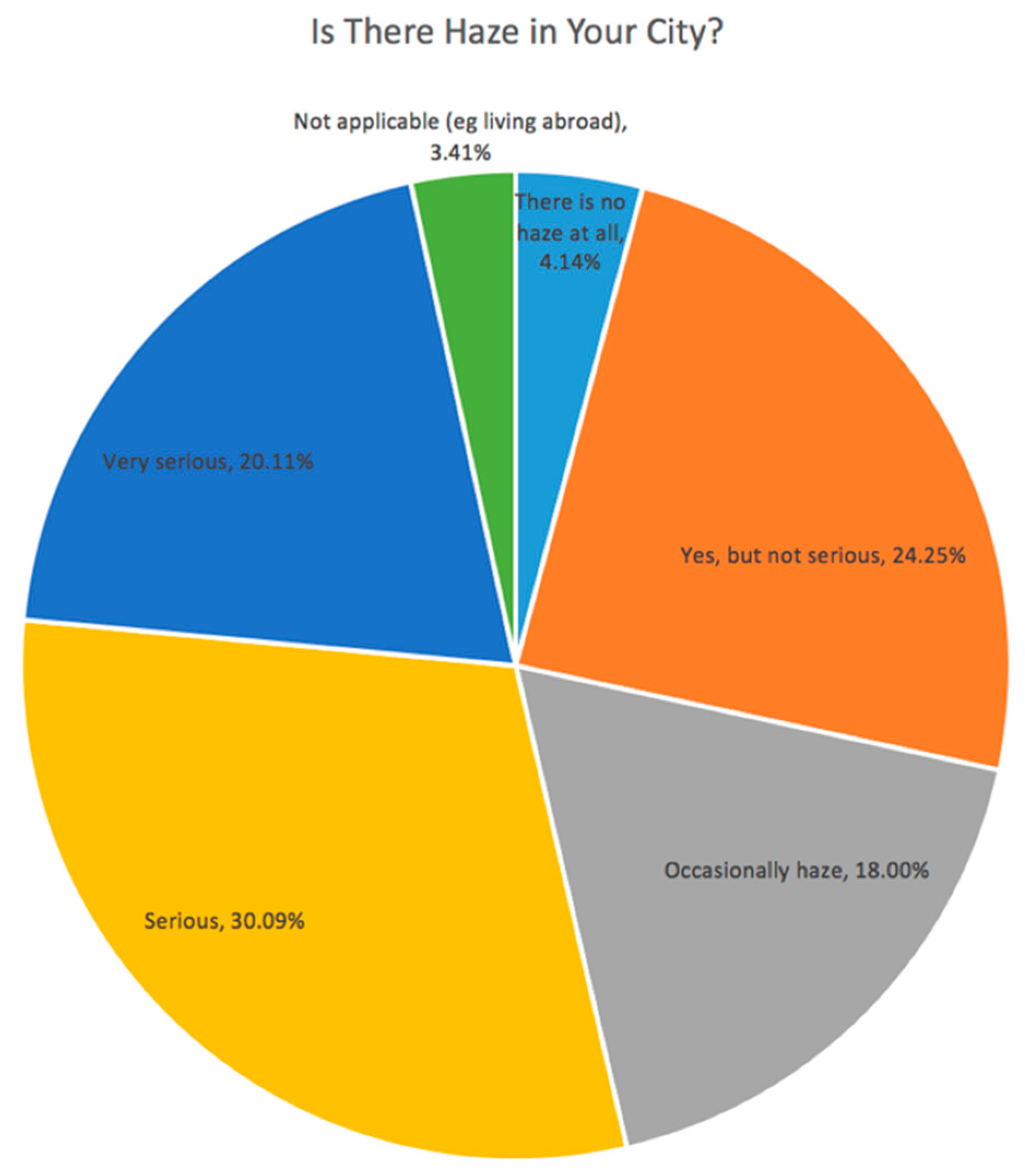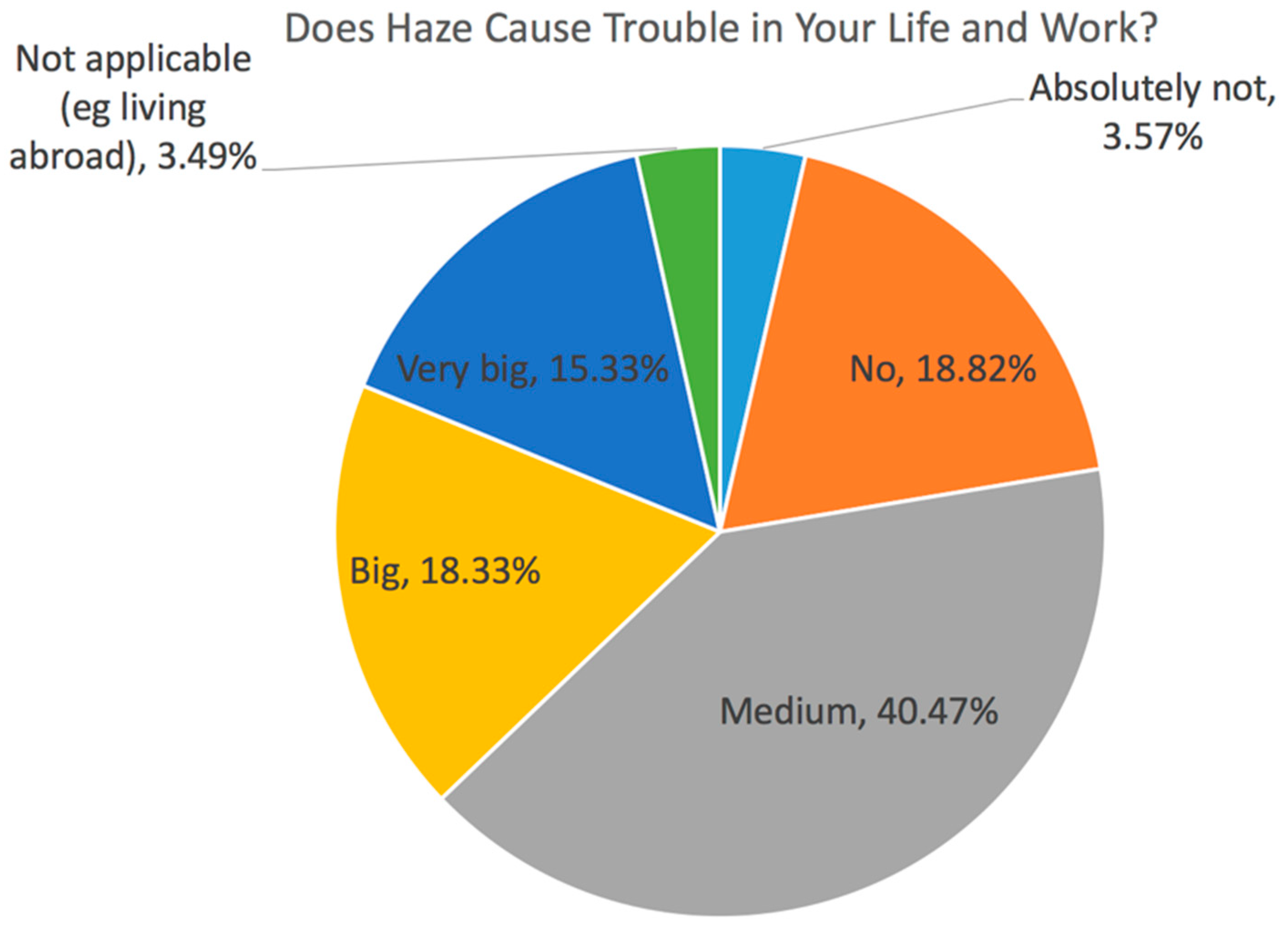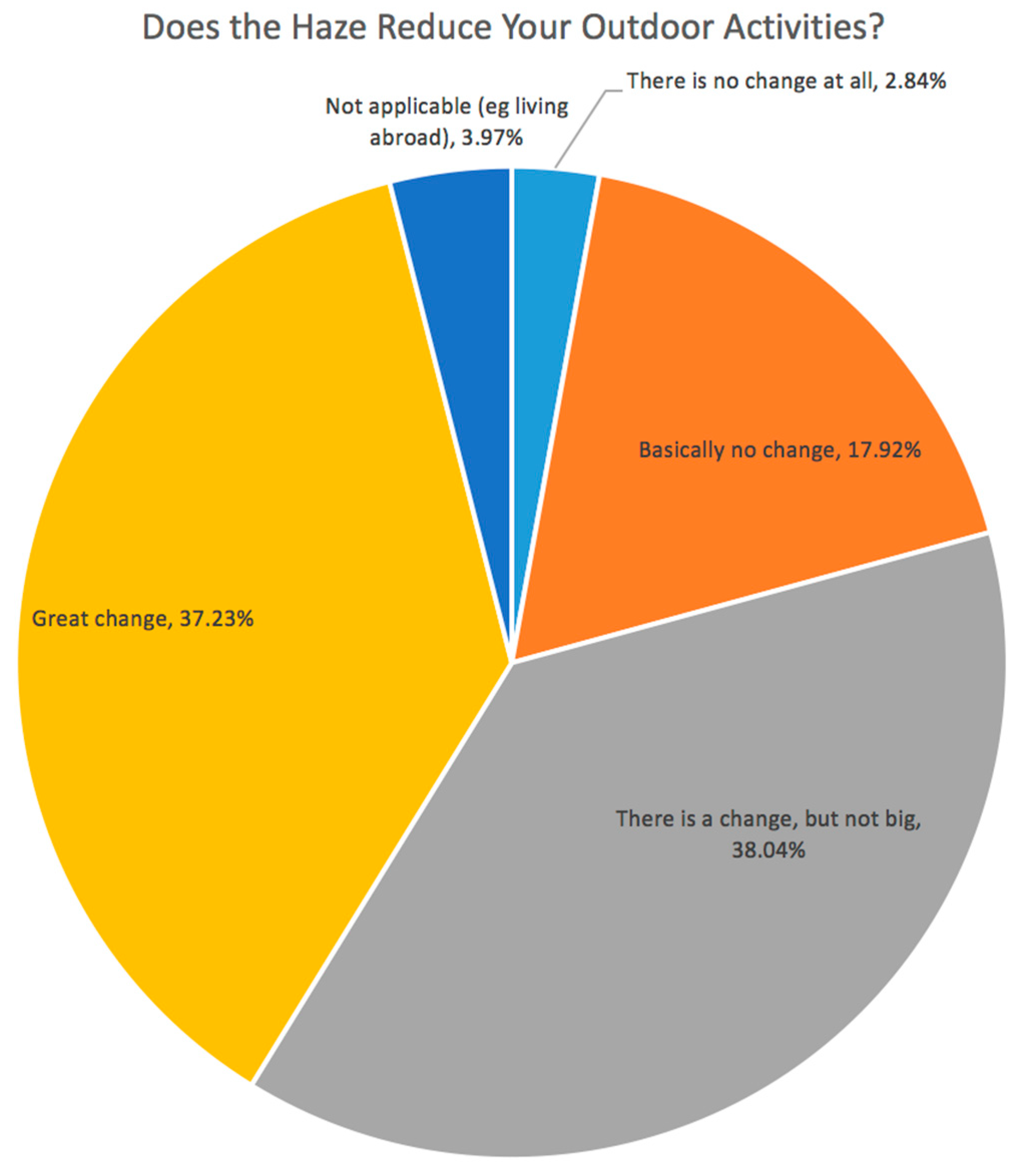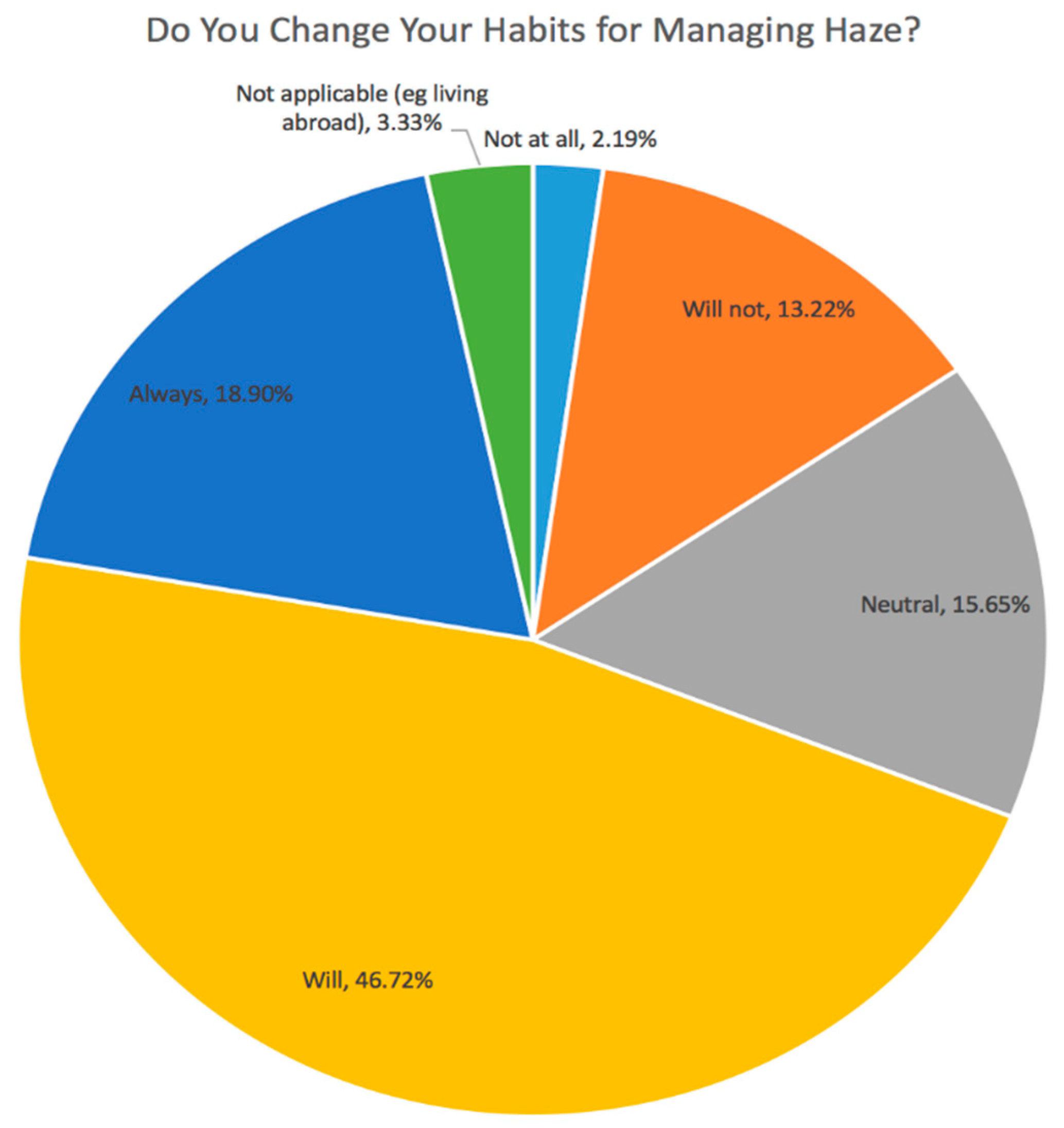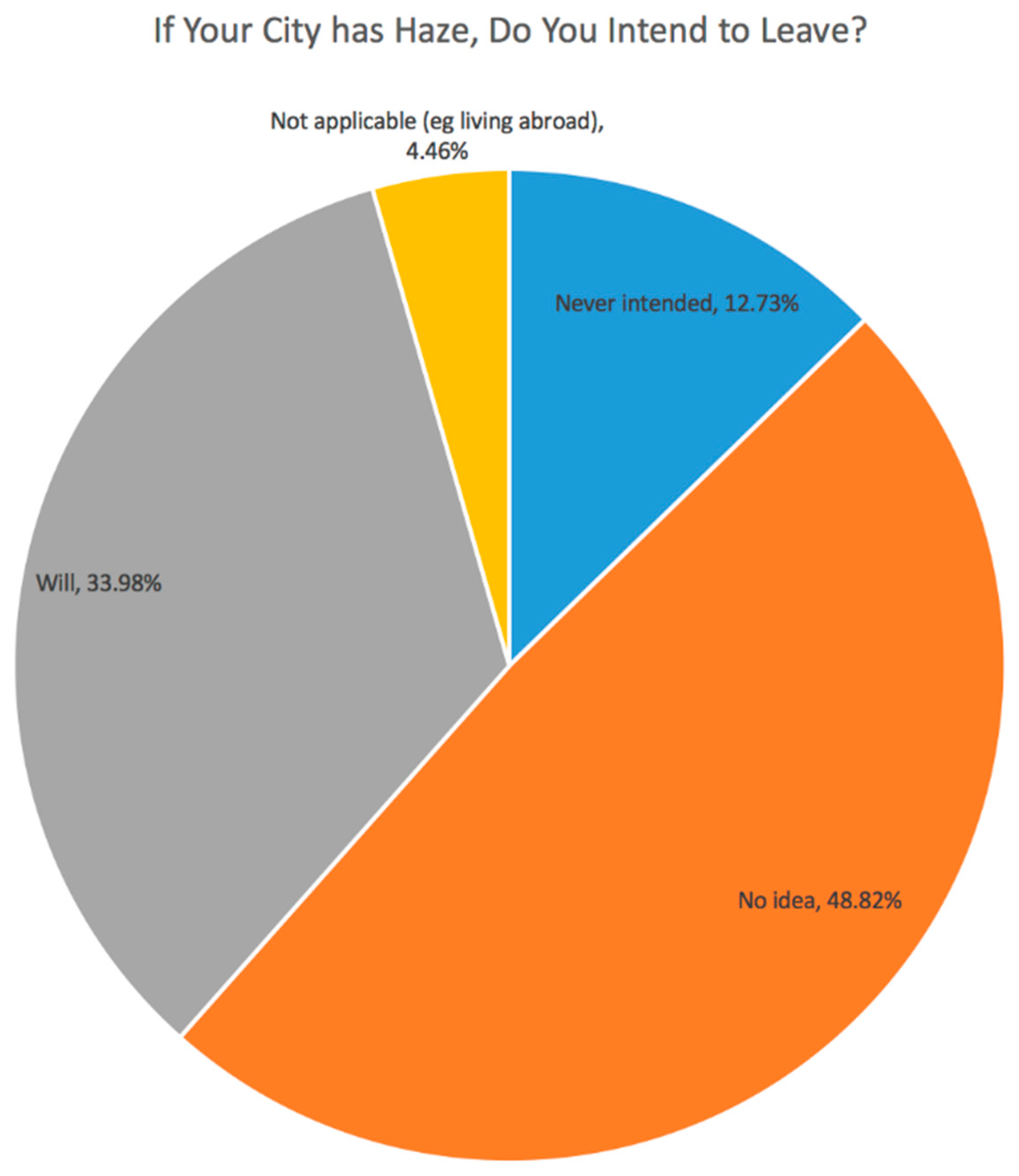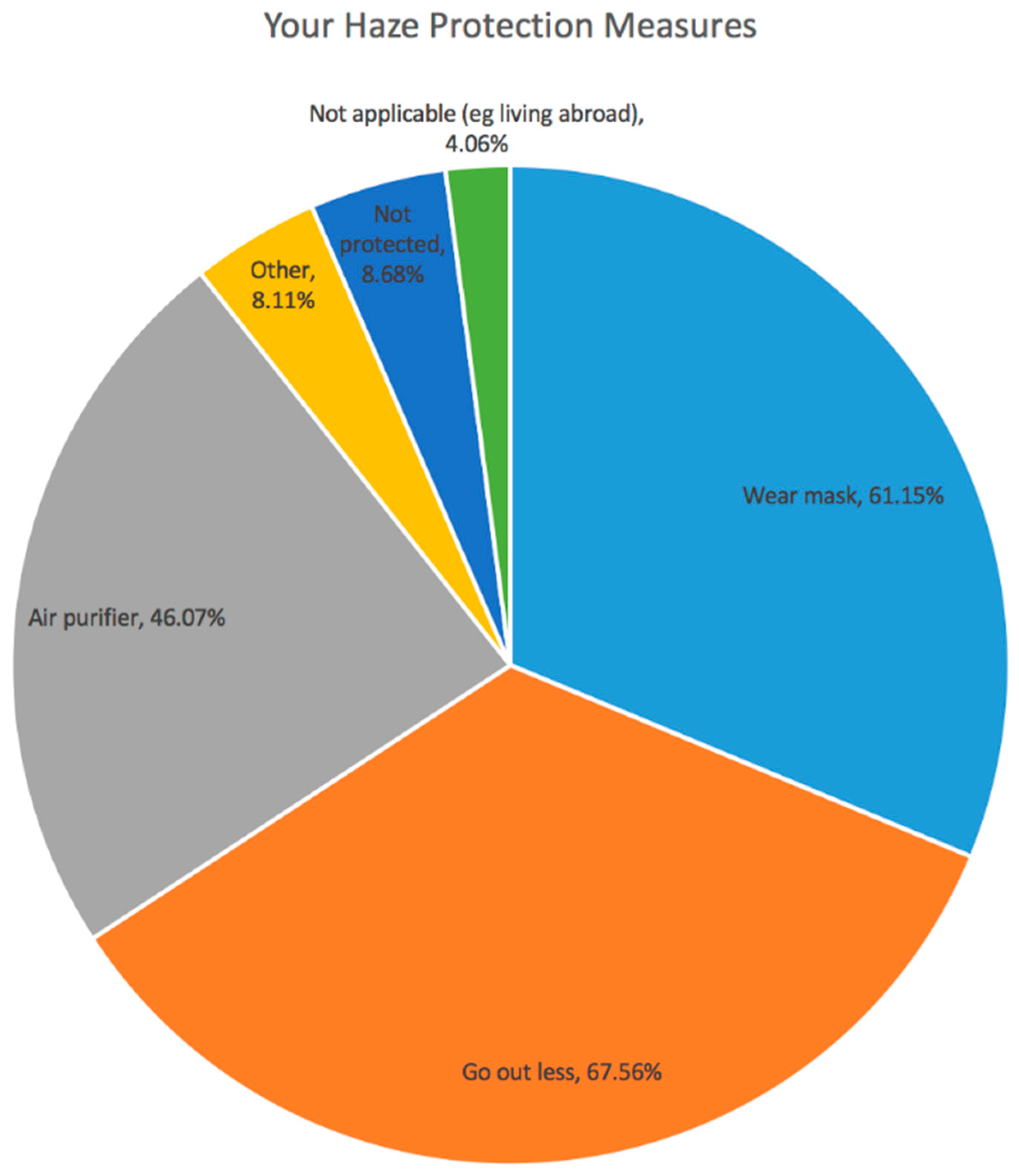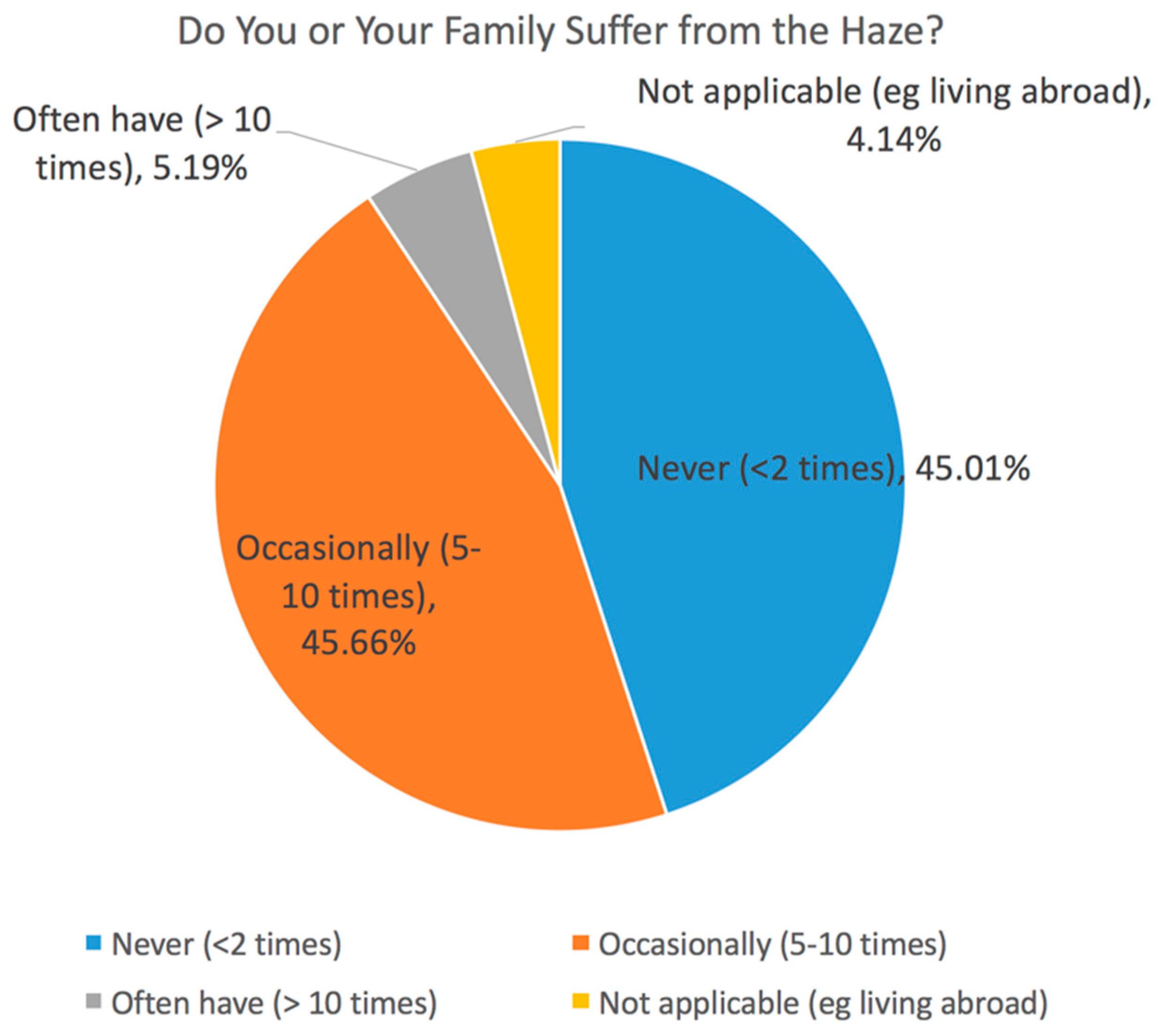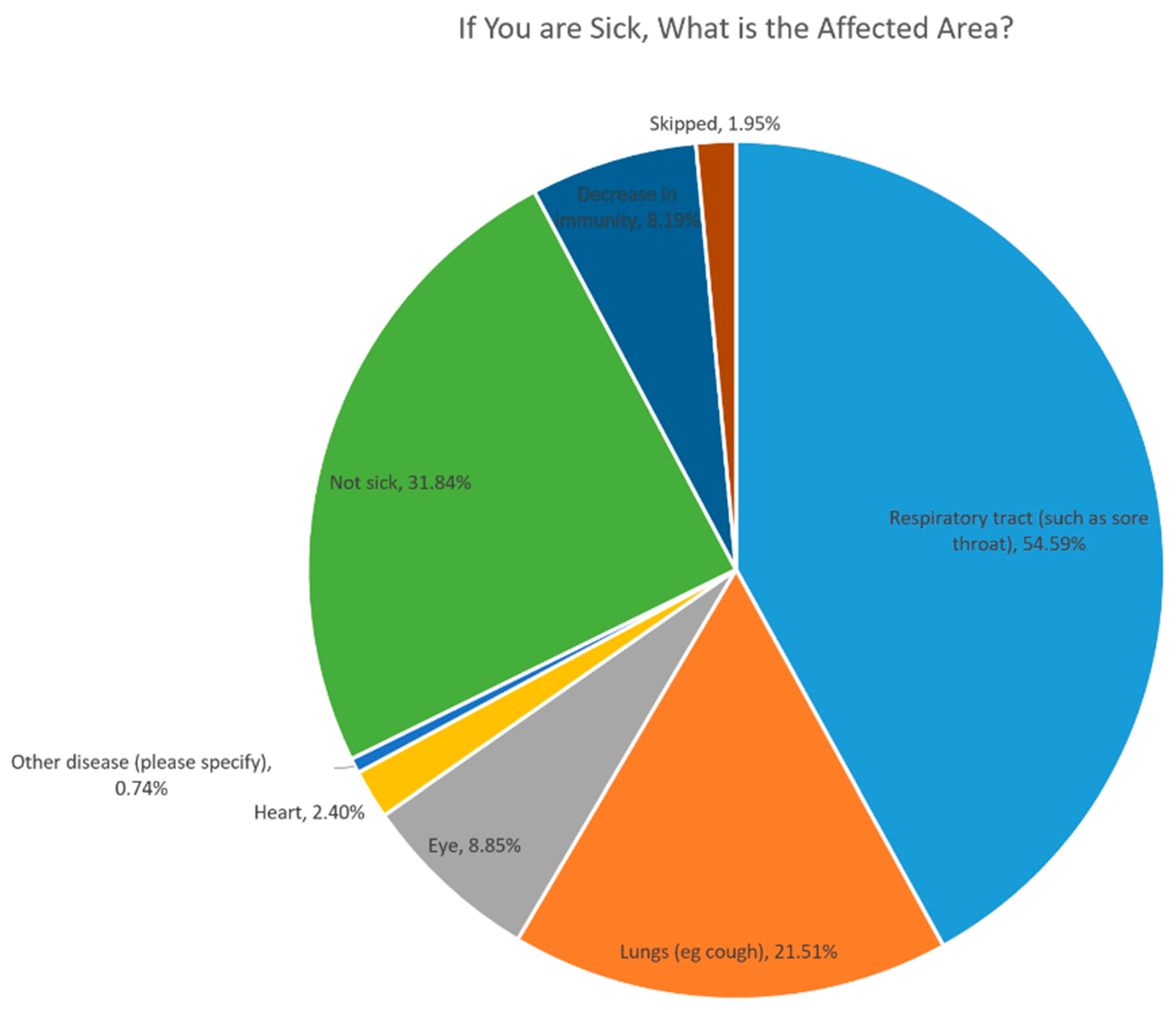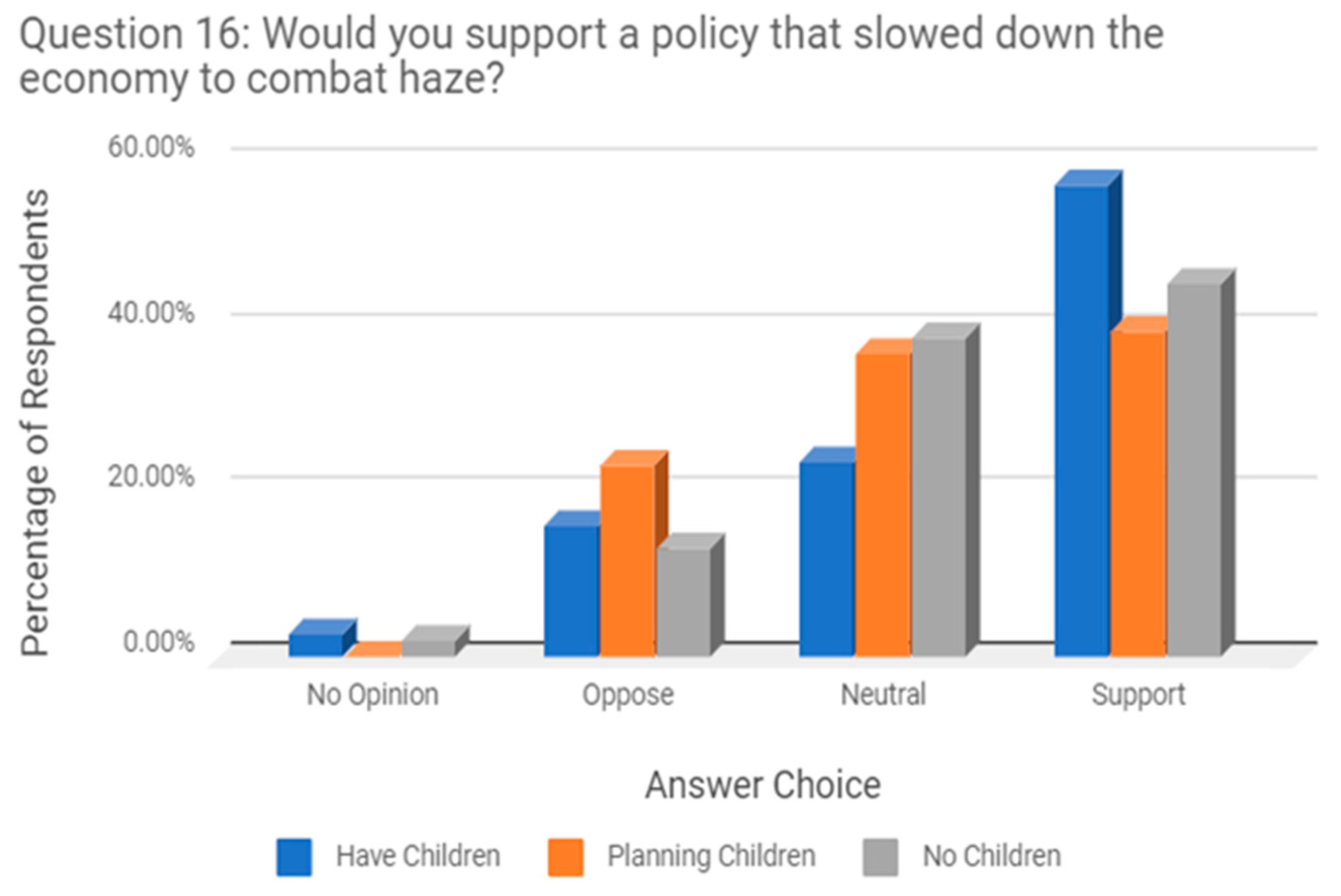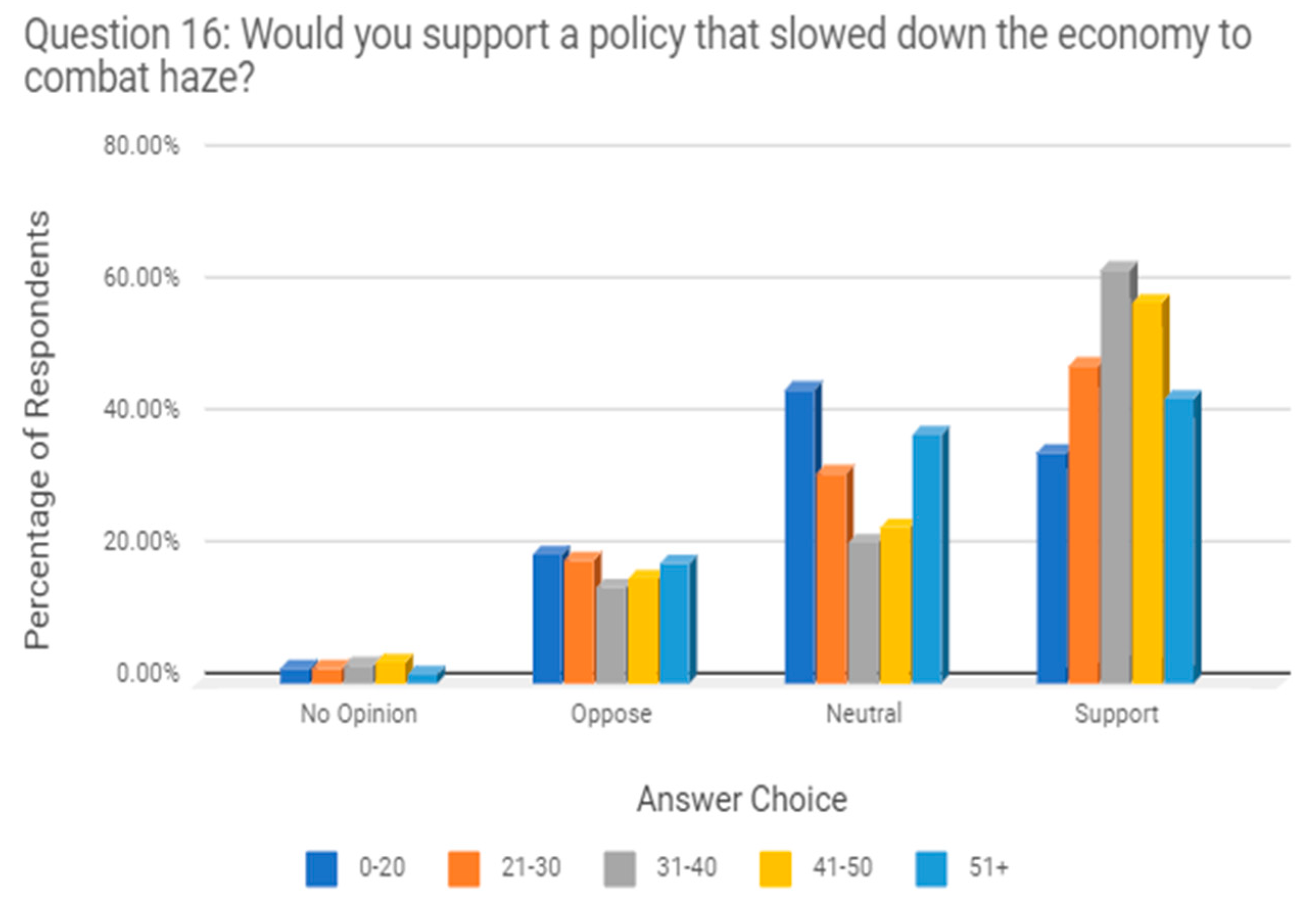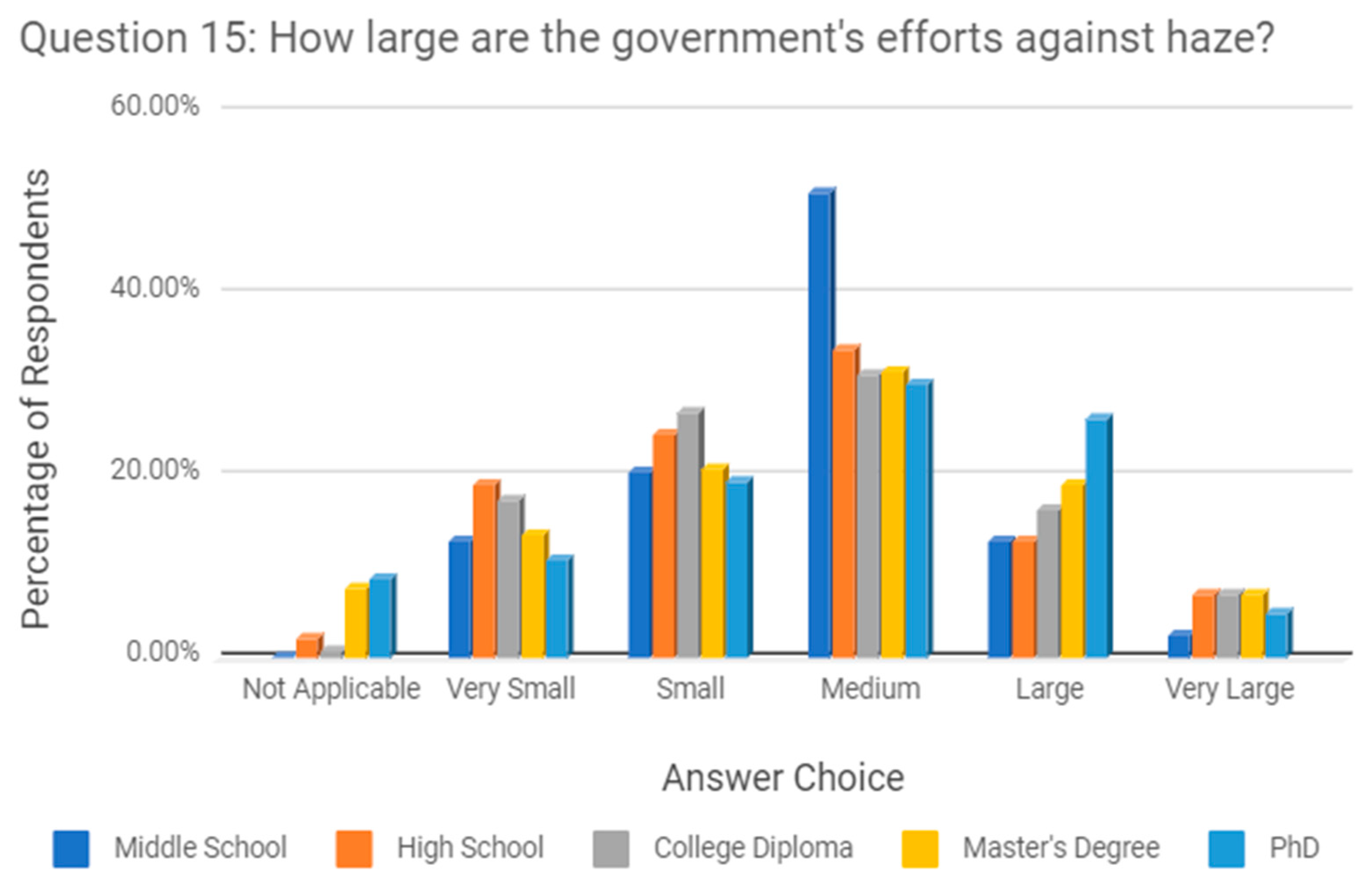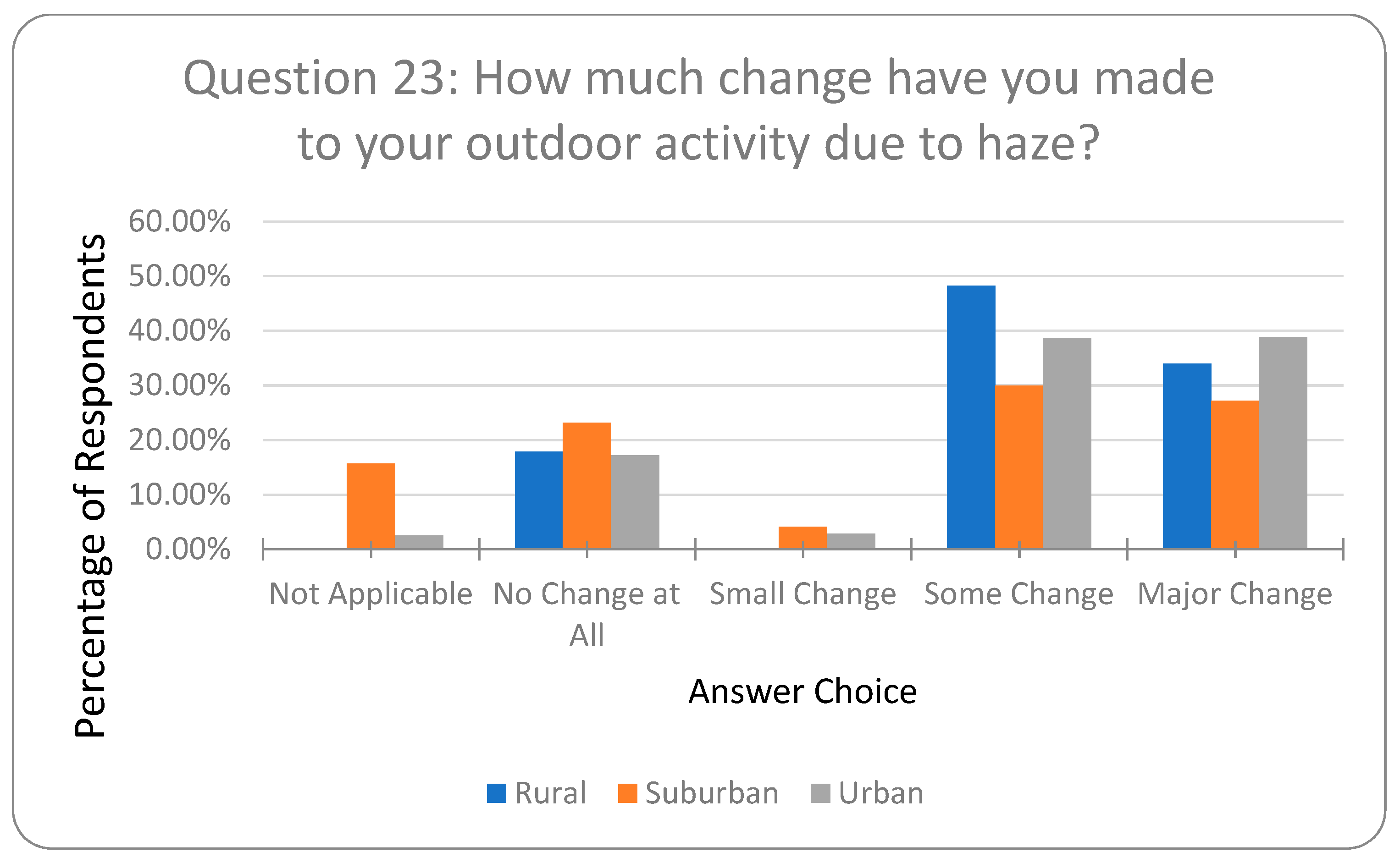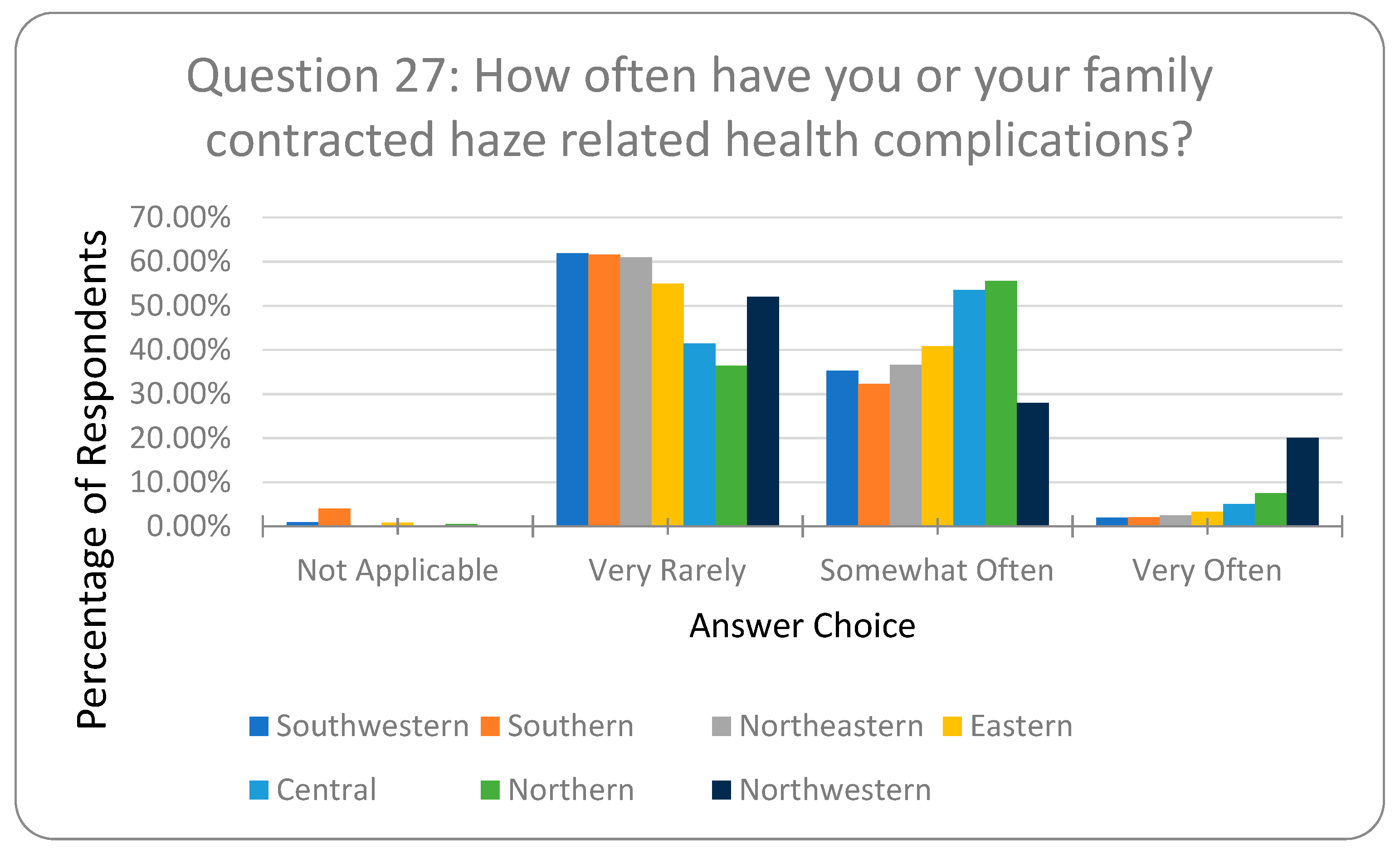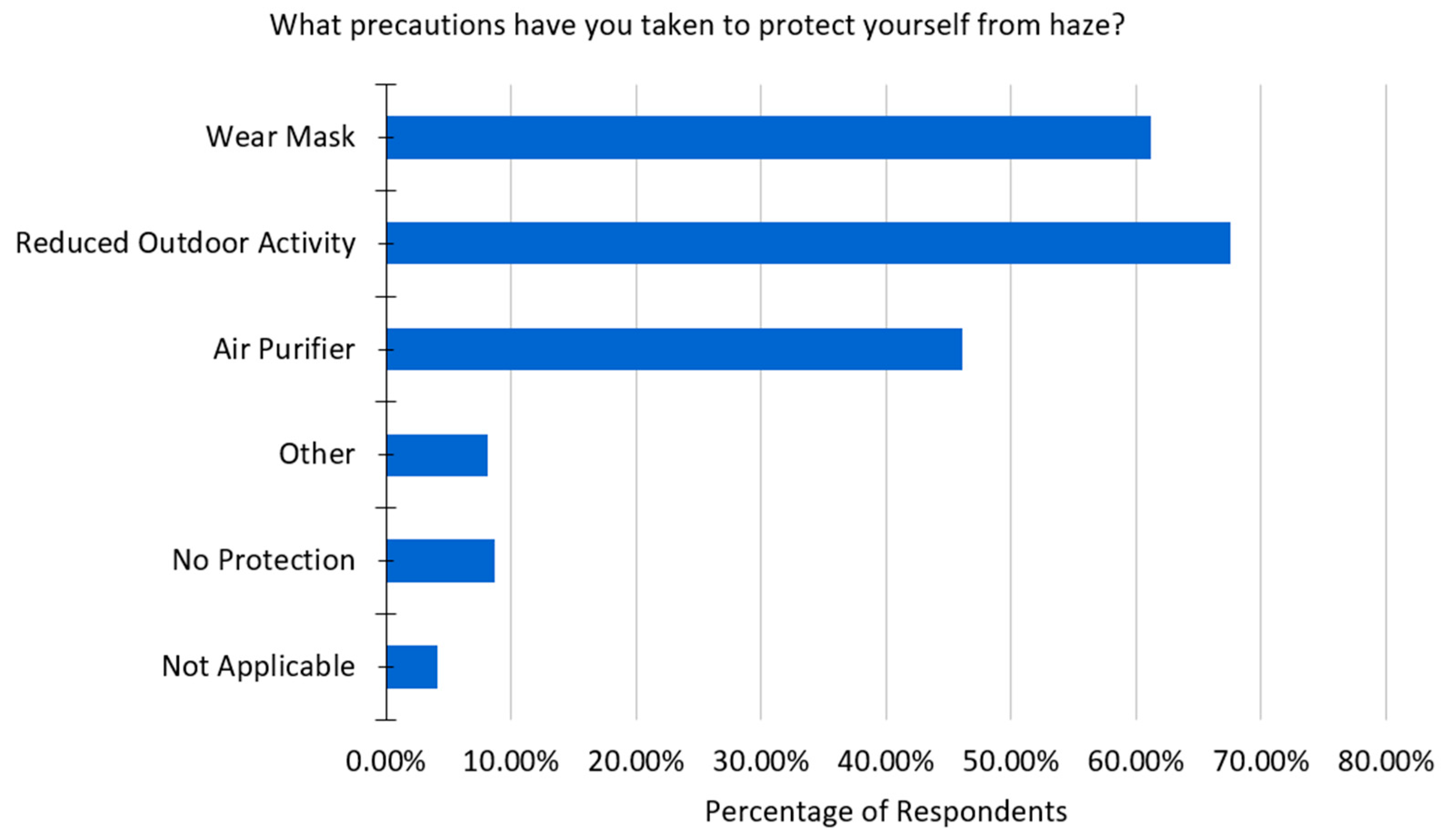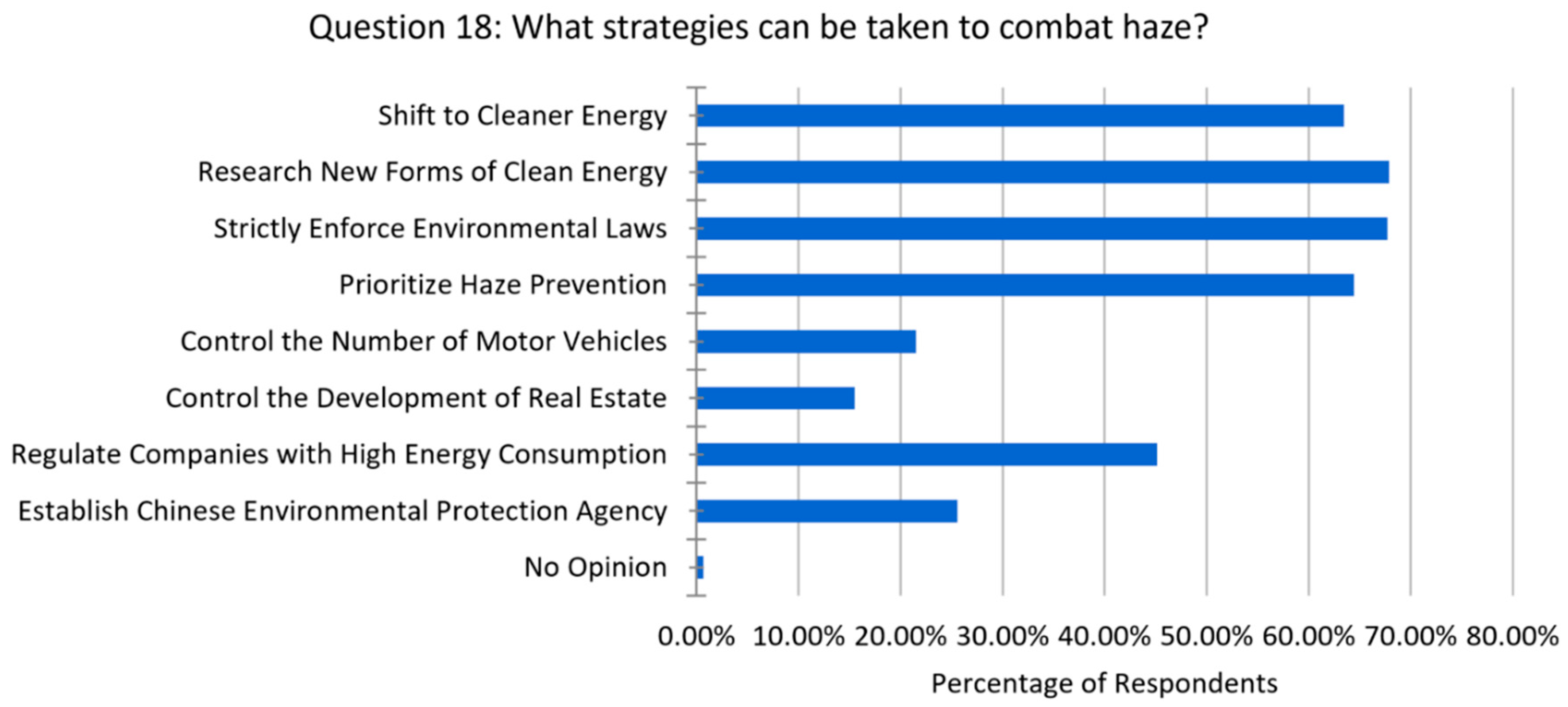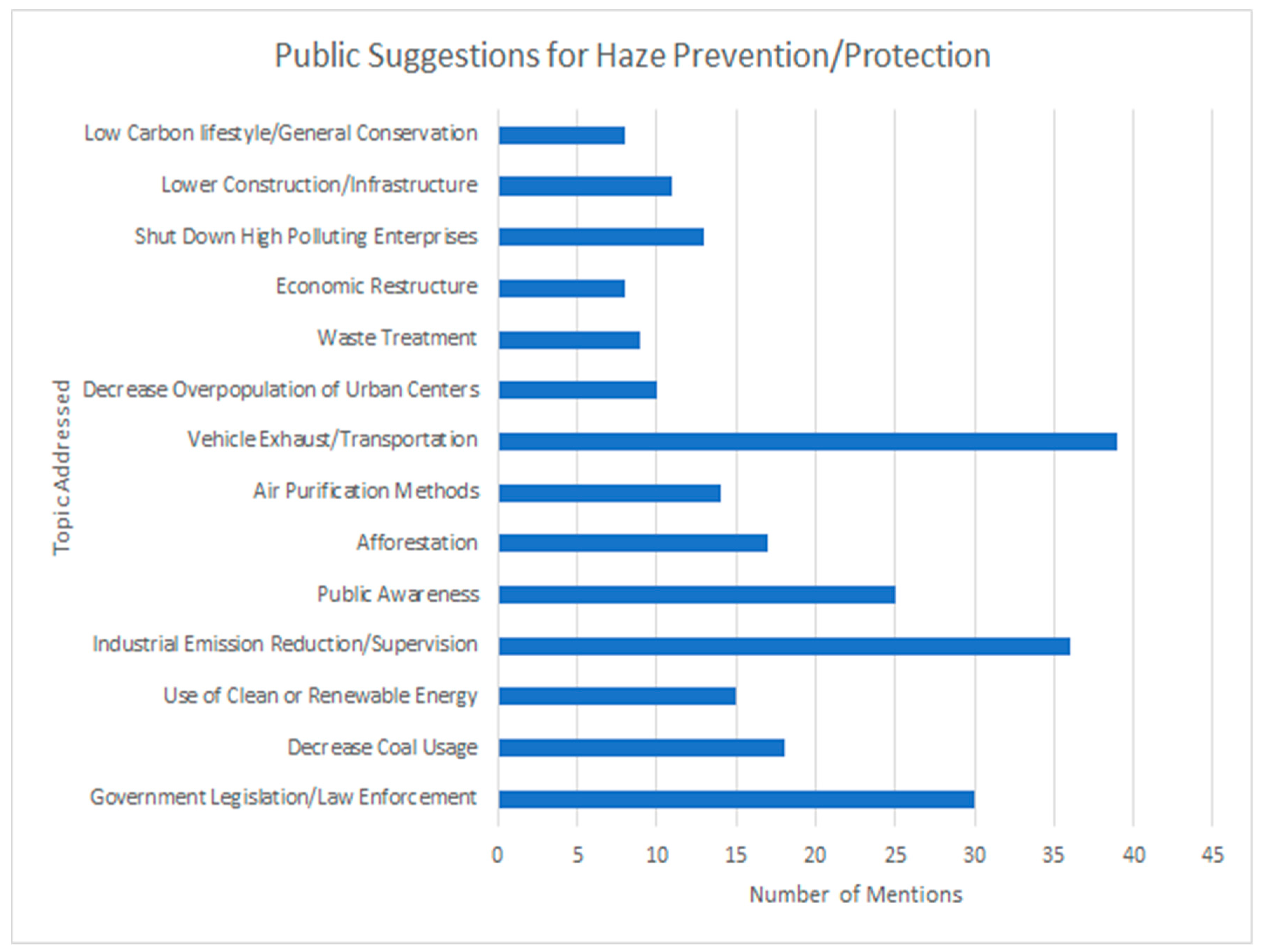Figure 1.
An illustrative diagram for principal component analysis. The red color points show the three-dimensional data, which can be represented by their projections onto a two-dimensional space coordinated by the first two principal components (i.e., PC1 and PC2). In this figure, the projects onto PC1 has higher variance than those onto PC2.
Figure 1.
An illustrative diagram for principal component analysis. The red color points show the three-dimensional data, which can be represented by their projections onto a two-dimensional space coordinated by the first two principal components (i.e., PC1 and PC2). In this figure, the projects onto PC1 has higher variance than those onto PC2.
Figure 2.
The result for Question 1 “What is your gender?”: The number of males and females that responded to the survey were roughly equal.
Figure 2.
The result for Question 1 “What is your gender?”: The number of males and females that responded to the survey were roughly equal.
Figure 3.
The result Question 2 “Do you have children?”: Most respondents had children, and only 6.67% of respondents did not plan to have children.
Figure 3.
The result Question 2 “Do you have children?”: Most respondents had children, and only 6.67% of respondents did not plan to have children.
Figure 4.
The result for Question 3 “How old are you?”: There were more older people than younger people, with 63.66% of the respondents being above 40.
Figure 4.
The result for Question 3 “How old are you?”: There were more older people than younger people, with 63.66% of the respondents being above 40.
Figure 5.
The result for Question 4 “What is your education background?”: The respondents were generally well-educated, with 82.88% having college diplomas or higher.
Figure 5.
The result for Question 4 “What is your education background?”: The respondents were generally well-educated, with 82.88% having college diplomas or higher.
Figure 6.
The result for Question 5 “What is your occupation?”: Office workers pulled ahead numerically, making up 20.11% of the participants.
Figure 6.
The result for Question 5 “What is your occupation?”: Office workers pulled ahead numerically, making up 20.11% of the participants.
Figure 7.
The result for Question 6 “What area (population density) do you live in?”: Most of the people surveyed live in cities.
Figure 7.
The result for Question 6 “What area (population density) do you live in?”: Most of the people surveyed live in cities.
Figure 8.
The result for Question 7 “What region of China do you live in?”: It seems that 67.40% of the respondents lived in northern, eastern, or northeastern China.
Figure 8.
The result for Question 7 “What region of China do you live in?”: It seems that 67.40% of the respondents lived in northern, eastern, or northeastern China.
Figure 9.
The result for Question 8 “What impact did haze have on your life in the past 10 years?”: 28.39% of respondents stated that haze had a medium level negative impact on their lives. Overall, 22.47% of respondents said haze had a big impact on their lives, and 18.82% stated it had a very large impact. A small impact was selected by 18.57%, and very small impact was selected by 9.08%.
Figure 9.
The result for Question 8 “What impact did haze have on your life in the past 10 years?”: 28.39% of respondents stated that haze had a medium level negative impact on their lives. Overall, 22.47% of respondents said haze had a big impact on their lives, and 18.82% stated it had a very large impact. A small impact was selected by 18.57%, and very small impact was selected by 9.08%.
Figure 10.
The result for Question 9 “How did the environment change in the past 10 years?”: 72.91% of those surveyed stated that the environment had gotten worse or much worse in the past ten years.
Figure 10.
The result for Question 9 “How did the environment change in the past 10 years?”: 72.91% of those surveyed stated that the environment had gotten worse or much worse in the past ten years.
Figure 11.
The result for Question 10 “How will the environment change in China in the future?”: It is noted that 35.44% of people had a negative prediction on the potential for improvement of the environment China, but 50.36% believed the environment would get better.
Figure 11.
The result for Question 10 “How will the environment change in China in the future?”: It is noted that 35.44% of people had a negative prediction on the potential for improvement of the environment China, but 50.36% believed the environment would get better.
Figure 12.
The result for Question 11 “How long do you think Chinese can get haze resolved?”: 27.33% of people believed that haze pollution in China would be solved in 5–10 years, with 8.52% of people choosing less than 5 years; 13.79% of people chose 10–15 years; 15.25% of people chose in 15–20 years; and 27.82% of people chose 20 years or longer to solve haze.
Figure 12.
The result for Question 11 “How long do you think Chinese can get haze resolved?”: 27.33% of people believed that haze pollution in China would be solved in 5–10 years, with 8.52% of people choosing less than 5 years; 13.79% of people chose 10–15 years; 15.25% of people chose in 15–20 years; and 27.82% of people chose 20 years or longer to solve haze.
Figure 13.
The result for Question 12 “How did your life quality (with the consideration of both environment and economic conditions) in the past 10 years?”: 49.07% and 13.54% of people agreed that quality of life (with the consideration of economic conditions) in the past years for the general population changed for the “better” and “much better”, respectively. On the contrary, 15.9% said quality of life got worse, and for 6.24%, it got much worse, while 11.92% said their life quality did not change.
Figure 13.
The result for Question 12 “How did your life quality (with the consideration of both environment and economic conditions) in the past 10 years?”: 49.07% and 13.54% of people agreed that quality of life (with the consideration of economic conditions) in the past years for the general population changed for the “better” and “much better”, respectively. On the contrary, 15.9% said quality of life got worse, and for 6.24%, it got much worse, while 11.92% said their life quality did not change.
Figure 14.
The result for Question 13 “Do you think the economic development is a prominent cause of haze?”: 53.12% of respondents agreed that economic development and haze are connected by causation. In contrast, 15.82% disagreed that economic development has led to haze pollution, and 26.03% were neutral.
Figure 14.
The result for Question 13 “Do you think the economic development is a prominent cause of haze?”: 53.12% of respondents agreed that economic development and haze are connected by causation. In contrast, 15.82% disagreed that economic development has led to haze pollution, and 26.03% were neutral.
Figure 15.
The result for Question 14 “Do you agree the haze pollution impair the economic growth?”: 59.77% of respondents agreed that haze affected economic development, 12.65% disagreed that haze affected economic development, and 21.33% were neutral.
Figure 15.
The result for Question 14 “Do you agree the haze pollution impair the economic growth?”: 59.77% of respondents agreed that haze affected economic development, 12.65% disagreed that haze affected economic development, and 21.33% were neutral.
Figure 16.
The result for Question 15 “How do you rate the government’s effort in handling the haze pollution?”: 24.57% believed national efforts to control haze were small, and 16.06% believed the efforts were very small, totaling 40.63% who believed efforts were small or very small. Overall, 17.11% believed the efforts were big, 6.73% believed the efforts were very big, for a total of 23.84% who believed there was a large effort. Overall, 32.28% believed there was medium national effort.
Figure 16.
The result for Question 15 “How do you rate the government’s effort in handling the haze pollution?”: 24.57% believed national efforts to control haze were small, and 16.06% believed the efforts were very small, totaling 40.63% who believed efforts were small or very small. Overall, 17.11% believed the efforts were big, 6.73% believed the efforts were very big, for a total of 23.84% who believed there was a large effort. Overall, 32.28% believed there was medium national effort.
Figure 17.
The result for Question 16 “Do you support the policy of slowing down the economic growth to reduce the haze pollution?”: 54.26% of respondents stood by a government policy that would slow down economic growth to focus on haze policy and prevention. Overall, 27.17% were neutral, and 16.14% disagreed with such a policy.
Figure 17.
The result for Question 16 “Do you support the policy of slowing down the economic growth to reduce the haze pollution?”: 54.26% of respondents stood by a government policy that would slow down economic growth to focus on haze policy and prevention. Overall, 27.17% were neutral, and 16.14% disagreed with such a policy.
Figure 18.
The result for Question 17 “Which option do you agree to handle the economic growth versus the haze pollution?”: 76.32% of people agreed that a clean economic development plan would be the best course of action as a measure to control the haze. This is opposed to 17.44% who believed that haze prevention should be vigorously managed before economic growth is considered, and only 2.35% who believed in an economy-first plan over environmental protection.
Figure 18.
The result for Question 17 “Which option do you agree to handle the economic growth versus the haze pollution?”: 76.32% of people agreed that a clean economic development plan would be the best course of action as a measure to control the haze. This is opposed to 17.44% who believed that haze prevention should be vigorously managed before economic growth is considered, and only 2.35% who believed in an economy-first plan over environmental protection.
Figure 19.
The result for Question 18 “Which three approaches do you choose to handle the haze pollution?”: A majority of people supported the need for an increase in environmental awareness, strict environmental monitoring, the development of clean energy, and the adjustment of energy structure. Specifically, 67.88% of those surveyed preferred the development of clean energy.
Figure 19.
The result for Question 18 “Which three approaches do you choose to handle the haze pollution?”: A majority of people supported the need for an increase in environmental awareness, strict environmental monitoring, the development of clean energy, and the adjustment of energy structure. Specifically, 67.88% of those surveyed preferred the development of clean energy.
Figure 20.
The result for Question 19 “Does the global warming affect the haze pollution?”: Almost half the people (46.47%) thought that climate change affected haze.
Figure 20.
The result for Question 19 “Does the global warming affect the haze pollution?”: Almost half the people (46.47%) thought that climate change affected haze.
Figure 21.
The result for Question 20 “Are you concerned about the haze pollution (e.g., check daily PM2.5)?”: 91.40% of the Chinese people were sometimes or very concerned about the haze and checked daily PM2.5 value.
Figure 21.
The result for Question 20 “Are you concerned about the haze pollution (e.g., check daily PM2.5)?”: 91.40% of the Chinese people were sometimes or very concerned about the haze and checked daily PM2.5 value.
Figure 22.
The result for Question 21 “Is there haze in the city you live in?”: Only 4.14% said that there was no haze in their city, while 50.20% had serious or very serious haze in their cities.
Figure 22.
The result for Question 21 “Is there haze in the city you live in?”: Only 4.14% said that there was no haze in their city, while 50.20% had serious or very serious haze in their cities.
Figure 23.
The result for Question 22 “Does haze cause trouble in your daily life or work?”: 74.13% of those surveyed were affected in life and at work.
Figure 23.
The result for Question 22 “Does haze cause trouble in your daily life or work?”: 74.13% of those surveyed were affected in life and at work.
Figure 24.
The result for Question 23 “Does haze change your outdoor activities?”: 75.27% reduced outdoor activity because of the haze.
Figure 24.
The result for Question 23 “Does haze change your outdoor activities?”: 75.27% reduced outdoor activity because of the haze.
Figure 25.
The result for Question 24 “Do you change your habits (e.g., taking buses instead of driving personal cars) due to the haze pollution?”: 65.62% changed their habits to adjust to the haze.
Figure 25.
The result for Question 24 “Do you change your habits (e.g., taking buses instead of driving personal cars) due to the haze pollution?”: 65.62% changed their habits to adjust to the haze.
Figure 26.
The result for Question 25 “Do you intend to leave if your city has haze?”: 48.82% of the people did not know if they would leave their city because of the haze, but 33.98% of them planned to leave.
Figure 26.
The result for Question 25 “Do you intend to leave if your city has haze?”: 48.82% of the people did not know if they would leave their city because of the haze, but 33.98% of them planned to leave.
Figure 27.
The result for Question 26 “Which approaches did you use to protect yourself (multiple options can be chosen)?”: Many people said they used an air purifier (46.07%), went out less (67.56%), and wore masks (61.15%) to protect themselves from haze.
Figure 27.
The result for Question 26 “Which approaches did you use to protect yourself (multiple options can be chosen)?”: Many people said they used an air purifier (46.07%), went out less (67.56%), and wore masks (61.15%) to protect themselves from haze.
Figure 28.
The result for Question 27 “Did you or your family members get sick during the haze period?”: 45.66% of respondents had family that suffered from haze or suffered from it themselves, but another half did not.
Figure 28.
The result for Question 27 “Did you or your family members get sick during the haze period?”: 45.66% of respondents had family that suffered from haze or suffered from it themselves, but another half did not.
Figure 29.
The result for Question 28 “If you are sick, what is the affected area in your body?”: 54.59% of respondents were affected in their respiratory tract by haze. The lungs and eyes were the other major areas where respondents got sick.
Figure 29.
The result for Question 28 “If you are sick, what is the affected area in your body?”: 54.59% of respondents were affected in their respiratory tract by haze. The lungs and eyes were the other major areas where respondents got sick.
Figure 30.
Grouping of support for potential government policy by respondents’ child status. The percentage on the Y-Axis represents the percent of respondents in the specific group. For example, summing the percentages for all the bars representing people with children yield 100%.
Figure 30.
Grouping of support for potential government policy by respondents’ child status. The percentage on the Y-Axis represents the percent of respondents in the specific group. For example, summing the percentages for all the bars representing people with children yield 100%.
Figure 31.
Grouping of support for potential government policy by ages. Respondents were categorized into five age groups: 0–20, 21–30, 31–40, 41–50, and above 50.
Figure 31.
Grouping of support for potential government policy by ages. Respondents were categorized into five age groups: 0–20, 21–30, 31–40, 41–50, and above 50.
Figure 32.
Respondents’ opinion on government’s current policies against haze according to their educational backgrounds.
Figure 32.
Respondents’ opinion on government’s current policies against haze according to their educational backgrounds.
Figure 33.
Projections of respondents’ opinions on Q#8 (i.e., whether the negative impact on daily life was large), Q#9 (i.e., whether the environment became worse and worse in the last 10 years), Q#12 (i.e., whether the living quality, with the consideration of both economic and environment situations, became worse in the last 10 years), Q#22 (i.e., whether the haze pollution caused troubles in respondents’ work and daily life), and Q#23 (i.e., whether respondents reduced outdoor activities due to the haze pollution) onto a two-dimensional space coordinated by the first two principal components, i.e., PC1 and PC2. Bubbles represent an assembly of respondents, with larger sizes indicating more respondents. Vectors representing the five questions are shown in White color. The bubbles show the distribution of respondents’ opinions among the five questions.
Figure 33.
Projections of respondents’ opinions on Q#8 (i.e., whether the negative impact on daily life was large), Q#9 (i.e., whether the environment became worse and worse in the last 10 years), Q#12 (i.e., whether the living quality, with the consideration of both economic and environment situations, became worse in the last 10 years), Q#22 (i.e., whether the haze pollution caused troubles in respondents’ work and daily life), and Q#23 (i.e., whether respondents reduced outdoor activities due to the haze pollution) onto a two-dimensional space coordinated by the first two principal components, i.e., PC1 and PC2. Bubbles represent an assembly of respondents, with larger sizes indicating more respondents. Vectors representing the five questions are shown in White color. The bubbles show the distribution of respondents’ opinions among the five questions.
Figure 34.
The change of outdoor activities in respondents living in rural, suburban, and urban areas.
Figure 34.
The change of outdoor activities in respondents living in rural, suburban, and urban areas.
Figure 35.
Grouping of frequency of haze related sickness by respondents’ living regions. Respondents living in North China, Central China, and Northwest China suffered more in their health.
Figure 35.
Grouping of frequency of haze related sickness by respondents’ living regions. Respondents living in North China, Central China, and Northwest China suffered more in their health.
Figure 36.
Areas of the body of respondents having health issues likely caused by haze. Multiple choices could be selected by respondents. No sickness option shown in the figure means the respondents did not have any illness during the haze periods.
Figure 36.
Areas of the body of respondents having health issues likely caused by haze. Multiple choices could be selected by respondents. No sickness option shown in the figure means the respondents did not have any illness during the haze periods.
Figure 37.
Actions taken or items used by respondents to protect themselves from haze pollution. Multiple choices could be selected by respondents.
Figure 37.
Actions taken or items used by respondents to protect themselves from haze pollution. Multiple choices could be selected by respondents.
Figure 38.
Strategies selected by respondents for combatting haze. Multiple choices could be selected by respondents.
Figure 38.
Strategies selected by respondents for combatting haze. Multiple choices could be selected by respondents.
Figure 39.
Suggestions from the public for haze prevention or protection.
Figure 39.
Suggestions from the public for haze prevention or protection.
Table 1.
The opinions of respondents to policy that would slow down economic growth to reduce haze pollution.
Table 1.
The opinions of respondents to policy that would slow down economic growth to reduce haze pollution.
| | Respondents’ Opinions of Policy That Would Slow down Economic Growth in Order to Reduce Haze Pollution | Total |
|---|
| No Support | Neutral | Support | No Opinion |
|---|
| Ages | Below 21 years | 10 | 23 | 18 | 1 | 52 |
| 21 to 30 years | 39 | 81 | 93 | 3 | 216 |
| 31 to 40 years | 33 | 57 | 86 | 4 | 180 |
| 41 to 50 years | 62 | 92 | 273 | 11 | 438 |
| Above 50 years | 55 | 82 | 199 | 11 | 347 |
| Total | 199 | 335 | 669 | 30 | 1233 |
